Error tracking plays a vital role in ensuring the reliability and stability of software applications. With many developers exploring alternatives to Sentry, a widely used error monitoring platform, comprehensive comparisons are more important than ever. Recent updates to Sentry's Terms of Service, though later retracted, have spurred teams to evaluate other solutions. This article dives into the top 10 Sentry alternatives for error tracking in 2025, equipping you with the insights needed to choose the best option for your project.
Quick Guide - Sentry Alternatives
Here's a quick look at your best options for 2025, along with everything you need to know about making the switch.
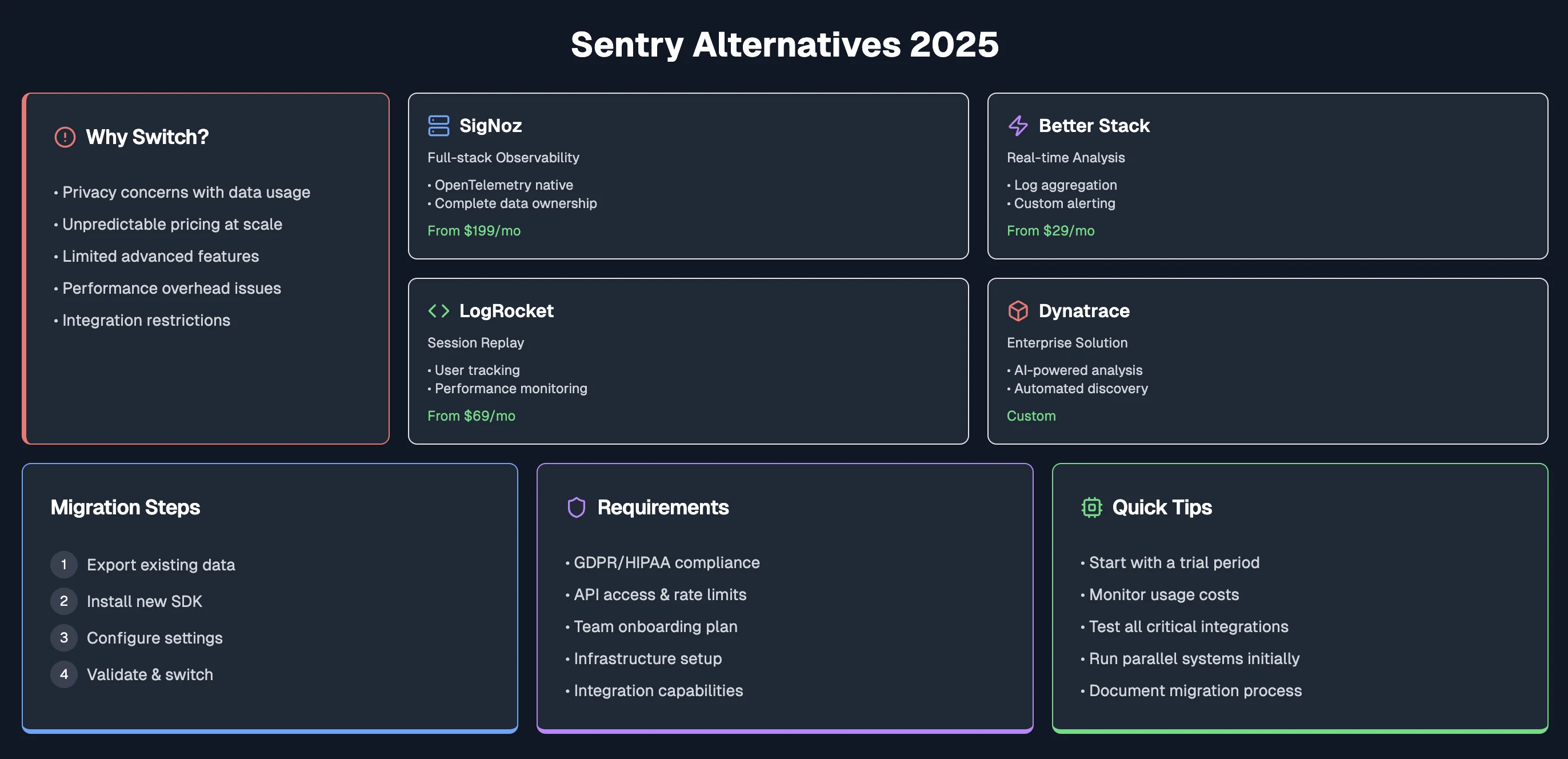
Now let's dive deeper into each alternative and really break down what makes them tick. We will walk you through the nitty-gritty details about pricing strategies, feature comparisons, and real-world performance – the kind of stuff that'll help you make a solid choice for your team.
Understanding the Need for Sentry Alternatives
Sentry has been a leading tool for error tracking and application monitoring, offering real-time error reporting, detailed stack traces, and performance insights. However, recent changes, though later retracted, have raised concerns among users, including:
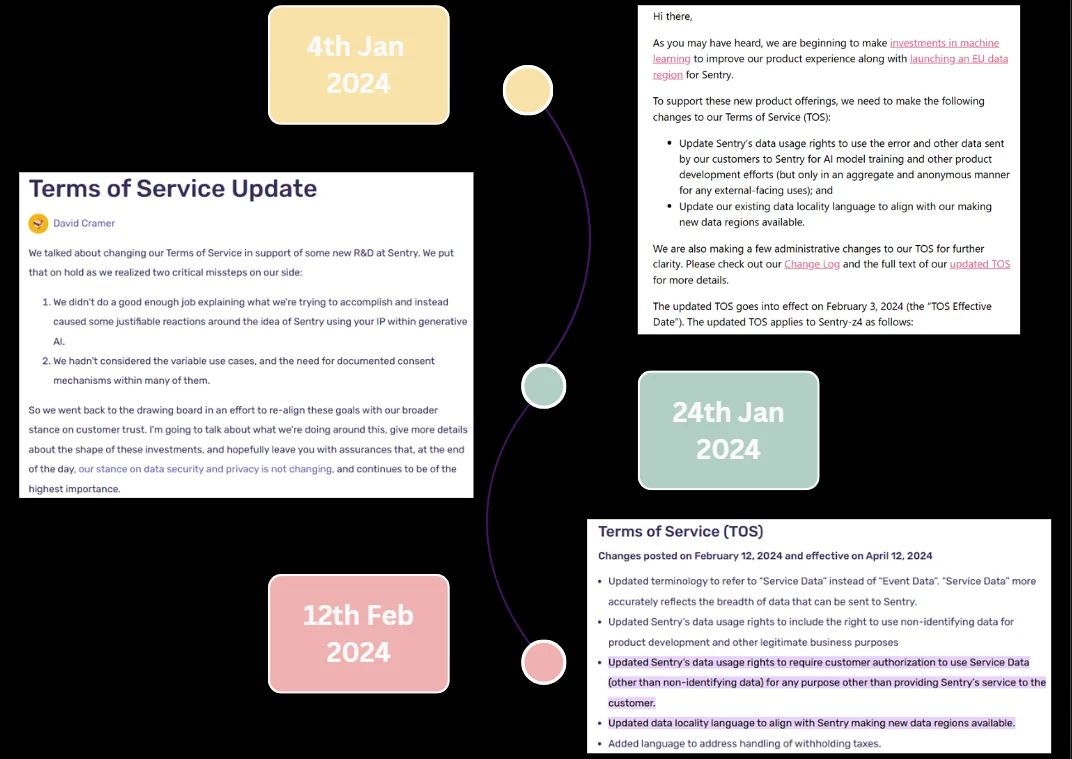
Privacy Concerns
Sentry's temporary TOS changes allowed using customer data to train AI models without an opt-out, sparking worries in regulated industries about data privacy, HIPAA compliance, IP, and PII. Although Sentry retracted these changes and promised clearer consent mechanisms, trust was damaged, leading organizations to question its long-term data security.
Pricing Changes
Sentry's pricing has become a challenge for startups and scaling teams, prompting the search for alternatives that offer more flexible pricing models or better value to meet growing needs.
Feature Limitations for Advanced Use Cases
While Sentry provides distributed tracing, it may lack the depth found in dedicated observability tools, limiting its effectiveness for complex microservices debugging. Its focus on error tracking over full observability makes it less suitable for comprehensive application performance monitoring.
Customization and Integration Boundaries
Sentry's APIs are flexible, but rate limits (e.g., 500 API calls per minute on free plans) can restrict high-frequency integrations. Additionally, plugins for less common tech stacks might be unsupported or require custom development, complicating integrations with niche tools.
Scalability
Under high event volumes, Sentry's performance may decline. For example, a social media platform experiencing a viral event could generate millions of error events per second, overwhelming Sentry's resources and necessitating additional infrastructure. In self-hosted setups, scaling involves managing more worker nodes, Redis instances, and Kafka clusters, increasing operational complexity.
These challenges drive the demand for alternatives that offer similar functionalities with added benefits, especially for:
Highly Regulated Industries
Healthcare, finance, and government sectors must comply with regulations like HIPAA and GDPR. They need tools that ensure compliance with detailed assurances, audit reports, and advanced security features such as encryption and access control. Sentry's TOS changes and lack of explicit compliance guarantees make it less appealing to these organizations.
Large Enterprises
Enterprises require full-stack observability platforms that integrate seamlessly across diverse systems, support hybrid or on-premises deployments, and offer advanced analytics. Sentry's focus on error tracking limits its ability to provide comprehensive insights, cross-team collaboration, and support for complex infrastructures. Its scalability may also fall short for enterprise-grade workloads.
Open-Source Advocates
Teams that prefer open-source tools value transparency, flexibility, and the ability to modify the codebase. While Sentry's open-source version is robust, its commercial offerings impose restrictions that limit customization. Open-source advocates may seek alternatives that encourage community involvement and avoid dependence on a single vendor's roadmap.
Startups
Startups need cost-effective, scalable error-tracking tools to match their growth. Usage-based pricing, flexible plans, and transparent cost structures are crucial. Sentry's event-based pricing can become expensive for startups handling high-frequency, low-priority errors. Additionally, startups may prefer lightweight tools with easy setups, proactive alerts, and integrations tailored for modern DevOps workflows—areas where Sentry may not fully meet their needs.
Key Features to Look for in Sentry Alternatives
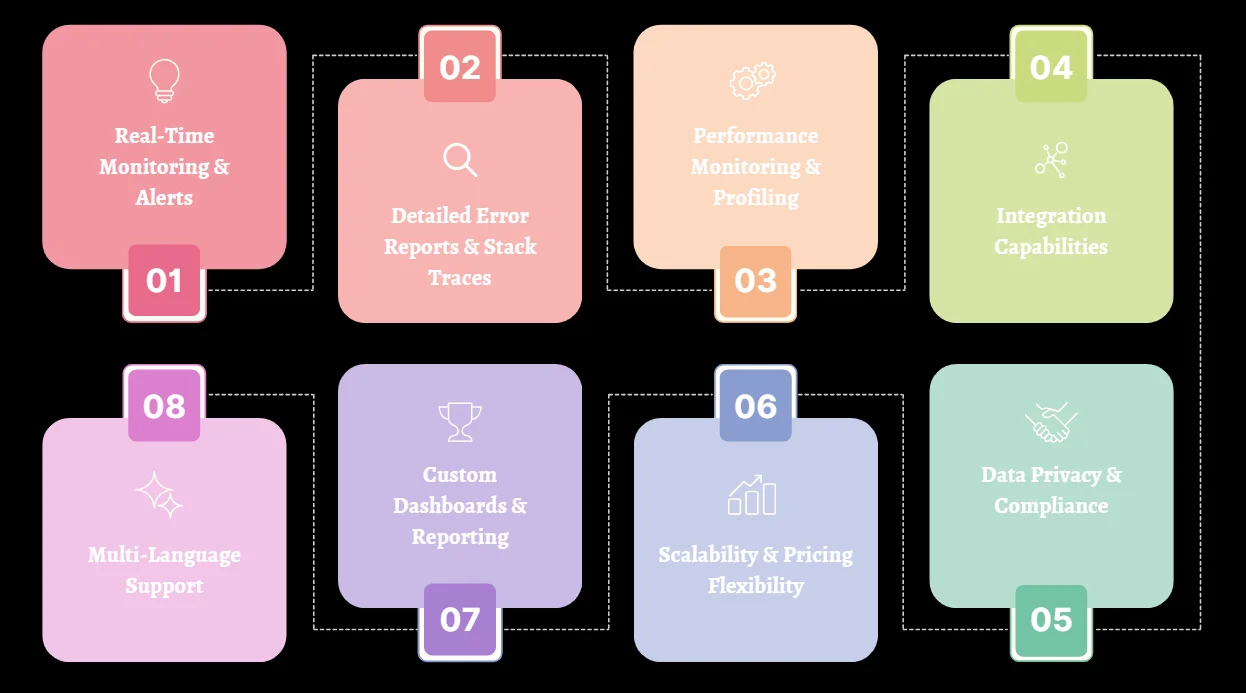
Real-Time Monitoring & Alerts
Rapid issue detection and instant notifications enable teams to address critical problems immediately, minimizing downtime and user impact.
For example, during a critical outage, real-time alerts can immediately notify the team of server downtime or database connection failures, enabling them to quickly investigate root causes and restore services. This minimizes user impact by allowing your team to take corrective actions before the problem affects a large portion of your user base.
Detailed Error Reports & Stack Traces
A comprehensive view of errors, including stack traces and user context, is essential for efficient debugging and faster resolution.
Performance Monitoring & Profiling
Tools like SigNoz track application speed, latency, and resource usage, helping identify bottlenecks and prioritize optimizations.
Integration Capabilities
Choose a solution that integrates seamlessly with existing development tools (CI/CD pipelines, issue trackers, communication platforms) to streamline workflows. For example, integrating with Jira can create issue tickets from error logs, while Slack can send real-time alerts to development channels.
Data Privacy & Compliance
Ensure the tool adheres to regulations like GDPR, HIPAA, or SOC 2, protecting sensitive data and maintaining compliance to avoid costly fines and reputational damage.
Scalability & Pricing Flexibility
As your application grows, a scalable tool is crucial for performance without excessive costs. Look for flexible pricing models that align with your budget. For instance, startups can benefit from tools that efficiently scale during traffic spikes, while enterprises can manage large data volumes effectively.
Custom Dashboards & Reporting
The ability to create tailored dashboards and reports allows teams to focus on relevant metrics. Customizable views help track specific KPIs, enhancing alignment with team objectives.
Multi-Language Support
A tool that supports multiple programming languages ensures consistent error and performance monitoring across diverse tech stacks, reducing the need for multiple tools.
Top 10 Sentry Alternatives for 2025

1. SigNoz
SigNoz is a powerful open-source unified observability tool. It combines APM, logs, traces, infrastructure monitoring, error tracking, and exception handling into a single platform, making it a strong alternative to Sentry with its emphasis on data privacy and flexibility.
Licensed under MIT, SigNoz serves as a versatile, full-stack observability solution that enables monitoring of metrics and traces, with log management features in development. It supports OpenTelemetry for instrumentation and includes ready-to-use charts and visualizations.
Key Features:
- Full-stack observability with metrics, traces, and logs: SigNoz provides a unified platform to monitor and troubleshoot applications by capturing and correlating metrics, traces, and logs, offering a holistic view of system performance and health.
- OpenTelemetry integration for standardized instrumentation: SigNoz natively supports OpenTelemetry, enabling seamless integration and standardized instrumentation for collecting and analyzing telemetry data across diverse systems.
- Custom dashboards and alerting: Users can create tailored dashboards and set up alerts to monitor key performance indicators, ensuring they are immediately informed of any anomalies or issues.
- On-premises and cloud deployment options: SigNoz supports both on-premises and cloud deployments, giving organizations the flexibility to choose based on their infrastructure, security, and compliance needs.
| Pros | Cons |
|---|---|
| ✅ Complete data ownership and privacy | ❌ More complex setup, but powerful visualizations |
| ✅ Highly customizable for specific use cases | ❌ May need additional resources if you decide to self-hosting |
| ✅ Active community support and regular updates | ❌ Teams new to OpenTelemetry may find integrating SigNoz challenging due to its reliance on OpenTelemetry SDKs. |
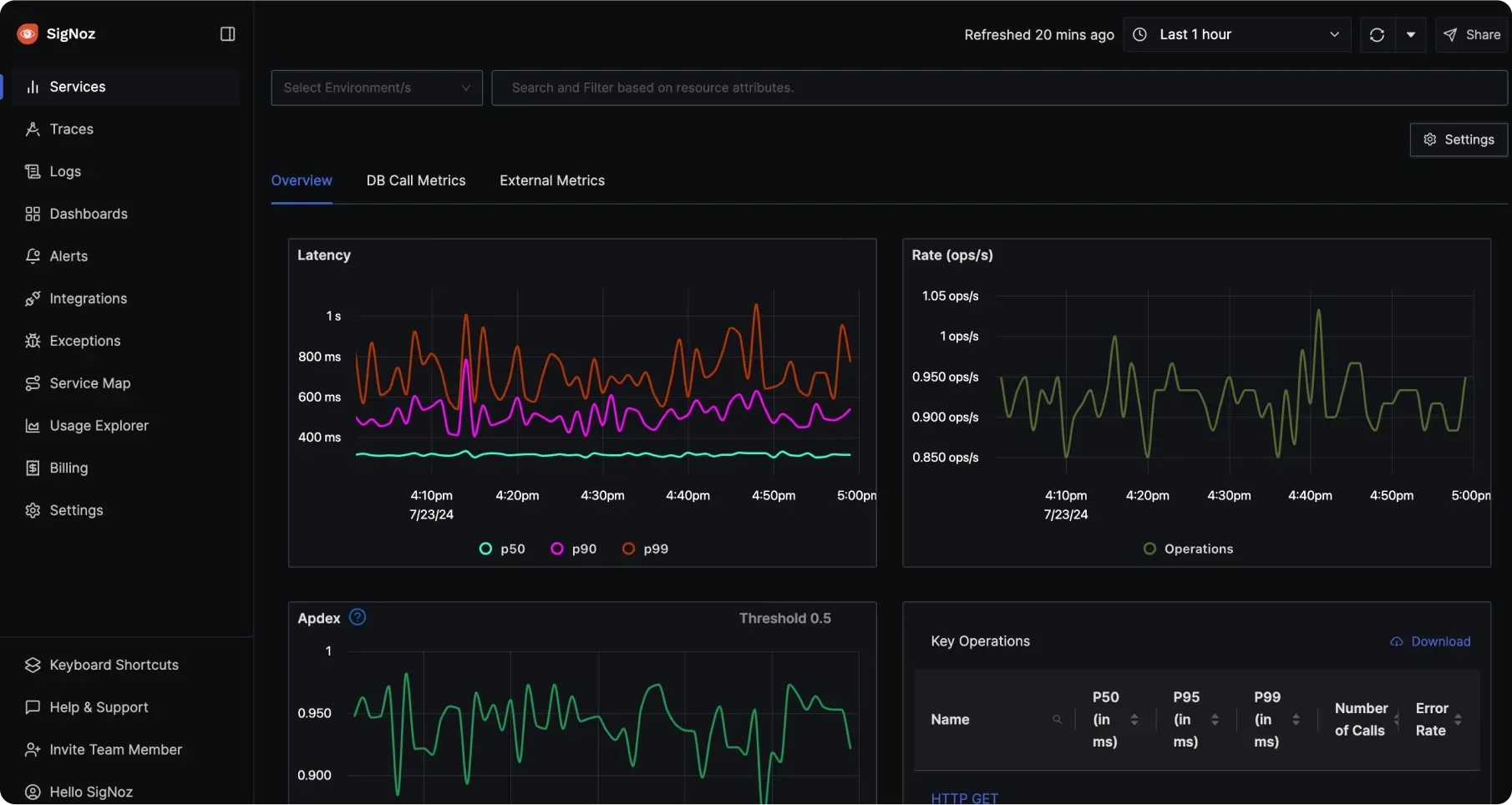
Comparison to Sentry
SigNoz offers comparable error tracking features with the added advantages of full observability and complete data control. While Sentry delivers a more refined out-of-the-box experience, SigNoz provides greater flexibility and significant cost savings as your needs scale. Its backend operates on Kafka+Druid or the OLAP database ClickHouse, with the query service built in Go and a front-end powered by TypeScript.
Pricing
Pricing Model
SigNoz relies on a usage-based pricing approach starting at
49/month, with additional charges based on data usage:0.3/GB for logs and traces and0.1/million metric samples **whereas sentry** utilizes an **event-based pricing** structure starting at29/month for 100,000 events. The cost scales with event volume and user count, making it less predictable.Cost Predictability
SigNoz's transparent pricing tied directly to usage ensures predictable costs, even as data scales. Teams benefit from clarity and better budget control whereas for sentry the per-event and per-user pricing can lead to unexpected cost increases, especially for high-volume teams.
Example Scenario For a team processing:
- Logs and Traces: 2GB per day (60GB/month).
- Metrics: 10 million samples per day (300 million samples/month).
Cost Calculations Cost Structure: Base + Traces + Metrics = Total Cost SigNoz: $49 (base) + (60GB × $0.3) + (300M × $0.1) = $103/month. Sentry: $26 (base) + (60GB x $0.22) + [(300M x $ varying cost above 10M) = $382] = $421.2/monthsource: sentry pricing
Instrumentation and performance overhead
Performance Impact:
Sentry excels in error tracking, particularly for front-end and mobile, but its SDKs can add notable performance overhead, increasing page load times by 5-10% in high-traffic scenarios. In contrast, SigNoz, built on OpenTelemetry, is resource-efficient, utilizing about 40% CPU capacity and employing distributed tracing and metrics collection to minimize performance impact, even under heavy loads.
Telemetry Support:
Sentry does not support advanced telemetry protocols like OTLP, limiting its use for standardized observability. In contrast, SigNoz utilizes OpenTelemetry, offering advanced telemetry with distributed tracing and metrics collection for enhanced flexibility and performance.
Resource Efficiency:
Sentry may experience performance issues under high event volumes. SigNoz, however, shows superior resource efficiency, outperforming tools like the Elastic Stack (ELK) in resource consumption, making it ideal for large-scale, high-traffic environments.
Data Architecture
Data Storage Technology:
SigNoz uses ClickHouse, a columnar database optimized for high-performance analytics on large datasets, ensuring efficient storage and fast querying for logs, metrics, and traces. In contrast, Sentry relies on PostgreSQL, which, while reliable for relational data, is not suited for high-volume, high-frequency data typical in observability systems.
Scalability and Performance:
ClickHouse enables SigNoz to scale efficiently and handle large datasets with low-latency querying for real-time insights. Sentry's PostgreSQL, while dependable, may encounter performance issues under high-throughput data ingestion and complex queries, limiting its scalability.
Handling High-Volume Data:
SigNoz is designed for efficient high-frequency data ingestion and large-scale datasets, making it ideal for distributed systems needing rapid data processing and real-time analysis. Sentry can store error events but may struggle with the demands of large-scale observability, hindering its scalability in high-volume environments.
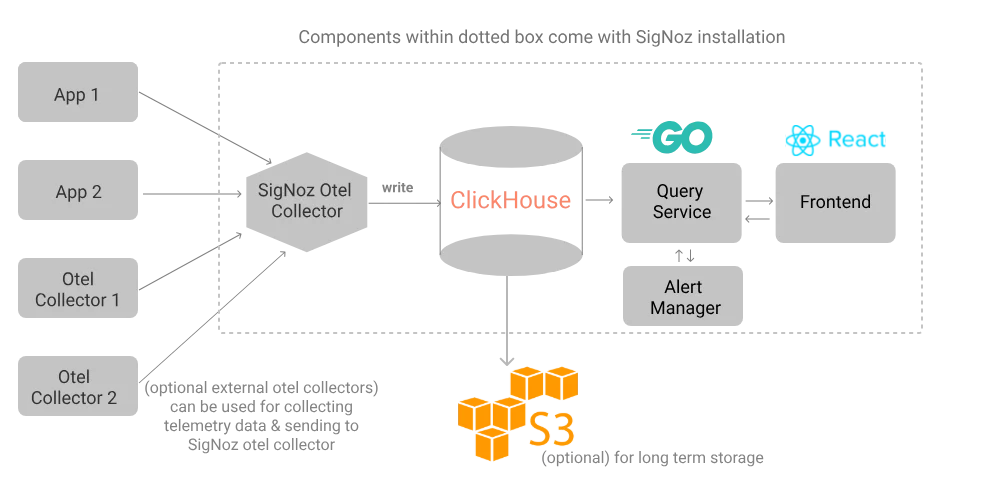
Customizations and integrations
Customization Options:
SigNoz offers a wide range of customization options, including the ability to create personalized dashboards, set up custom alerts, and define metrics tailored to user requirements. This flexibility allows businesses to align the tool more closely with their specific needs. In comparison, while Sentry provides integrations with popular tools like GitHub, Jira, and Slack, it doesn't offer the same level of flexibility in customizing dashboards and alerts, making it less adaptable than SigNoz in these areas.
Integration Flexibility:
SigNoz natively supports OpenTelemetry, ensuring smooth integration with a variety of technologies and frameworks. This approach provides flexibility across different use cases and is ideal for organizations seeking a standardized integration approach across their observability stack. On the other hand, Sentry offers integrations with tools like GitHub, Jira, and Slack, but its support for advanced telemetry protocols, like OTLP, is limited. This makes it less versatile for organizations seeking standardized integrations across their observability stack.
Support for Advanced Telemetry:
SigNoz offers stronger support for advanced telemetry protocols like OTLP, ensuring it is more versatile in handling a variety of observability needs. In contrast, Sentry lacks full support for advanced telemetry protocols like OTLP, limiting its ability to integrate with a broader observability ecosystem.
Security and compliance
| Aspect | SigNoz | Sentry |
|---|---|---|
| Encryption | Encryption in transit via HTTPS; secure connections for data transfer. | AES-256bit encryption at rest; HTTPS TLS connections for data transmission. |
| RBAC | Supports RBAC with basic roles; custom roles and audit logs coming soon. | Basic RBAC with roles like Billing, Member, Admin, Manager, and Organization Owner. |
| Compliance | SOC2 Type II Compliant, | |
| HIPAA Compliant, BAA Agreement | SOC2 Type I & II, HIPAA Attestation, ISO 27001. |
To get started with SigNoz cloud:
- Sign up at https://signoz.io
- Follow the instrumentation guide for your specific language/framework
- Start monitoring your application errors and performance in real-time
SigNoz stands out as a comprehensive open-source alternative to Sentry, offering full-stack observability with complete data ownership and native OpenTelemetry support.
2. Better Stack
Better Stack, formerly known as Logtail, is a modern observability platform with an emphasis on intuitive error tracking and real-time log management, designed to simplify debugging and improve software reliability. With powerful search capabilities, Better Stack helps you pinpoint the root causes of errors and understand your app's performance in real-time. Whether you're tackling tricky bugs or aiming to make your software more reliable, Better Stack's straightforward approach is here to support you every step of the way.
Key Features:
- Real-time log aggregation and analysis: Better Stack collects and processes logs in real-time, enabling quick identification and resolution of issues.
- Custom alerting and incident management: It includes built-in tools to set up custom alerts and manage incidents efficiently.
- Collaborative troubleshooting tools: Features like shared dashboards and comments foster team collaboration during debugging.
- Integrations with popular DevOps tools: Better Stack seamlessly integrates with tools like Slack, PagerDuty, and GitHub to enhance workflows.
| Pros | Cons |
|---|---|
| ✅ Intuitive interface for quick issue resolution | ❌ Less focus on APM compared to some alternatives |
| ✅Powerful log search and filtering | ❌ May require additional tools for full-stack monitoring |
| ✅ Built-in incident management features | ❌ Better Stack is not yet HIPAA compliant. |
Comparison to Sentry
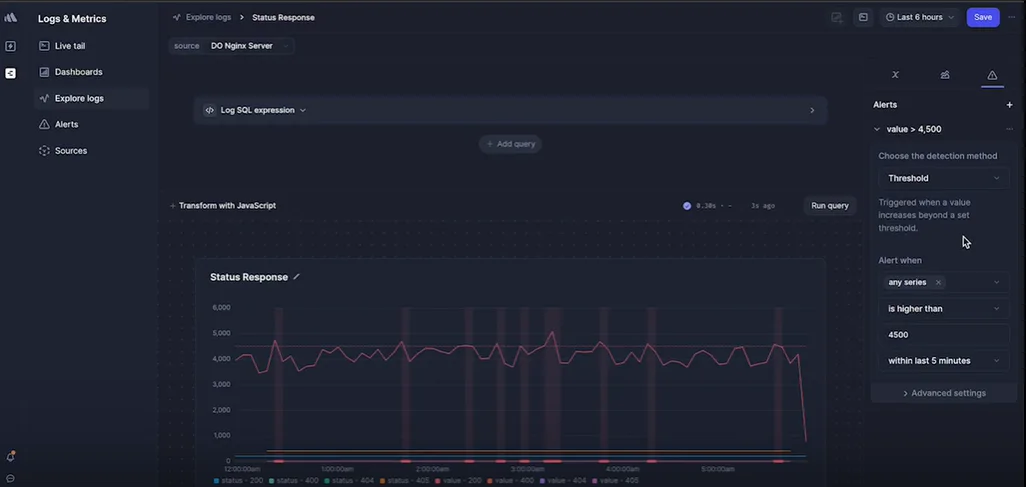
Better Stack excels in log management and error tracking, making it ideal for teams focused on log analysis. Its ecosystem, including Better Stack Logs and Better Stack Uptime, provides a comprehensive observability solution with built-in incident management. One-click integration with Better Uptime allows for easy notifications to on-call team members about application anomalies, whether from log errors or usage patterns.
Pricing
Pricing Model:
Better Stack offers a usage-based pricing model starting at $29 per month, which includes incident management, unlimited team members, 30-second checks, 30GB of logs retained for 7 days, and 2 billion metric data points retained for 30 days. In contrast, Sentry uses an event-based pricing model, where costs are tied to the number of events and users, making it harder to predict costs as teams grow.
Alerts and Notifications:
Better Stack includes unlimited alerts (phone calls, SMS, push notifications) in its base pricing with 30-second checks. On the other hand, Sentry charges extra for certain alerting features, depending on the plan chosen.
Cost Predictability and Scalability:
Better Stack offers a scalable model with minimal additional charges, making it more predictable for teams of any size. In comparison, Sentry's costs can escalate rapidly with increased event volumes or additional users, which may lead to challenges in cost management.
Guarantee and Risk-Free Trial:
Better Stack provides a 60-day money-back guarantee, giving teams flexibility to evaluate its offerings without financial risk. However, Sentry does not offer a money-back guarantee, which may be a consideration for teams evaluating their options.
Retention Periods:
Better Stack clearly defines its retention policies: logs are retained for 7 days and metrics for 30 days. Sentry's retention terms, however, can vary and may lack the clarity and flexibility offered by Better Stack.
Instrumentation and performance overhead
Log Processing Efficiency:
Better Stack is optimized for high-throughput environments, offering lightweight, distributed processing. It utilizes advanced log sampling mechanisms that provide precise control over log granularity, ensuring efficient log management even under heavy workloads. For example, Better Stack's log sampling can reduce CPU usage by 30-40% compared to other solutions, ensuring minimal performance impact.
On the other hand, Sentry prioritizes detailed error tracking and diagnostics, such as error grouping and context capture. While Sentry excels in error debugging, the processing and storing of this data can introduce significant overhead, particularly in large-scale or high-traffic applications. Sentry's detailed data processing can lead to up to 25% higher CPU usage due to the complexity and granularity of the data being stored and processed.
Impact on System Performance:
Better Stack is designed to maintain minimal latency and resource usage, even under heavy loads. Its approach ensures that log processing has minimal impact on the overall system performance. Better Stack adds less than 5% latency even during high traffic, making it a suitable choice for real-time log analysis in performance-sensitive environments.
In contrast, the detailed data that Sentry processes for error tracking and diagnostics can lead to higher resource demands. The need to capture and store large volumes of contextual data can cause up to 20-25% additional latency, especially in large-scale applications.
Granularity and Data Formats:
Better Stack supports structured data formats like JSON, which enable efficient indexing and querying while keeping resource usage low. The efficiency of its data formats results in significantly lower memory usage compared to systems that require more complex data structures.
Sentry, however, focuses on capturing rich diagnostic data, which, although valuable for debugging, can result in higher overhead due to the complexity and granularity of the data being stored and processed.
Data Architecture
Architecture Design:
Better Stack uses a custom-built architecture combined with ClickHouse for high-performance log storage and querying. This design is optimized for structured logging (e.g., JSON), which enables easy parsing and advanced observability features like anomaly detection and collaboration tools.
In comparison, Sentry also uses ClickHouse for columnar storage but focuses more on error tracking. It aggregates error events into "issues" for analysis, making it less suited for comprehensive log management compared to Better Stack's holistic approach.
Scalability:
Better Stack is designed for superior scalability, allowing it to handle large volumes of data efficiently and support real-time log analysis.
While Sentry is scalable as well, its focus on error aggregation means its architecture might not be as flexible or optimized for high-volume log management across diverse datasets.
Cost Efficiency:
Better Stack's custom pipelines and scalable design are optimized for cost-effective log analysis, making it a more budget-friendly option for large-scale log management.
On the other hand, Sentry, which primarily focuses on error tracking, may not provide the same level of cost efficiency for broader log management as Better Stack does.
Customizations and integrations
Flexible Log Sampling:
Better Stack allows flexible log sampling through application-level rules or logging frameworks, giving granular control over data volume and performance.
Real-Time Log Analysis:
In scenarios where real-time log analysis is critical, Better Stack's customizations enable dynamic log filtering and sampling, making it easier to identify and respond to issues in production environments.
High Log Throughput Handling:
Better Stack excels in environments with high log throughput (e.g., large-scale distributed systems), ensuring cost-efficiency through optimized log sampling and storage, which Sentry does not offer at the same level.
Incident Management:
Unlike Sentry, Better Stack is better suited for incident management by offering detailed and customizable logging views, allowing teams to quickly isolate and resolve issues without missing critical log data.
Integrations:
Better Stack has robust integration with OpenTelemetry, enabling users to collect logs, metrics, and traces from a wide variety of sources in a seamless and unified manner. Sentry, on the other hand, has more limited OpenTelemetry support, primarily focusing on error tracking, and may require additional setup for full observability.
Security and compliance
| Aspect | Better Stack | Sentry |
|---|---|---|
| Encryption | End-to-end encryption for logs Relevant data is encrypted at rest (AES-256) and in transit (HTTPS/TLS) | AES-256bit encryption at rest; HTTPS TLS connections for data transmission. |
| RBAC | RBAC with team-level isolation; supports custom roles. | Basic RBAC with roles like Billing, Member, Admin, Manager, and Organization Owner. |
| Compliance | SOC 2 Type II-compliant, GDPR-compliant, provides audit logs, and offers SSO integrations. | SOC2 Type I & II, HIPAA Attestation, ISO 27001. |
Better Stack excels in log management and real-time monitoring, with a focus on intuitive error tracking and transparent, usage-based pricing.
3. LogRocket
LogRocket combines error tracking with session replay, providing a unique perspective on user-facing issues. It offers a comprehensive frontend monitoring and product analysis platform, enabling you to replay sessions, evaluate frontend performance impact, analyze end-user experience, track errors, and assess metrics critical for conversions.
For example, LogRocket excels in reproducing complex user-reported bugs, allowing developers to see exactly how a user interacted with the application before encountering an issue, making debugging more efficient.
Additionally, by analyzing user journeys and pinpointing friction points, LogRocket can help improve conversion rates through UX analysis, such as identifying areas where users abandon their shopping carts or encounter obstacles in the checkout process. It also provides alerting and integrates with third-party tools for seamless incident management.
Key Features:
- Session replay and user interaction recording: LogRocket captures detailed recordings of user sessions, enabling developers to replay and analyze user interactions for better debugging and UX optimization.
- Front-end performance monitoring: It tracks key frontend metrics like page load time, JavaScript errors, and slow network requests to ensure optimal user experience. However, LogRocket's backend monitoring capabilities are limited, primarily focusing on the frontend. To complement this, integrating tools like Datadog or New Relic for backend monitoring can provide a more comprehensive view of the application's performance, helping teams track server-side issues, database queries, and API performance alongside frontend metrics.
- Error correlation with user actions: LogRocket correlates errors with specific user actions, providing invaluable context for debugging and resolving issues.
- Redux and React integration: It offers seamless integration with popular frontend frameworks like React and Redux for enhanced state management and debugging.
| Pros | Cons |
|---|---|
| ✅ Detailed context for customer-facing errors | ❌ Primarily focused on front-end and may require additional tools for back-end monitoring |
| ✅ Powerful debugging tools for front-end issues | ❌Privacy concerns with session recording (though customizable) |
| ✅ Easy integration with popular JavaScript frameworks | ❌ It provides SDKs, but they are not open source like the ones offered by Sentry. |
Comparison to Sentry
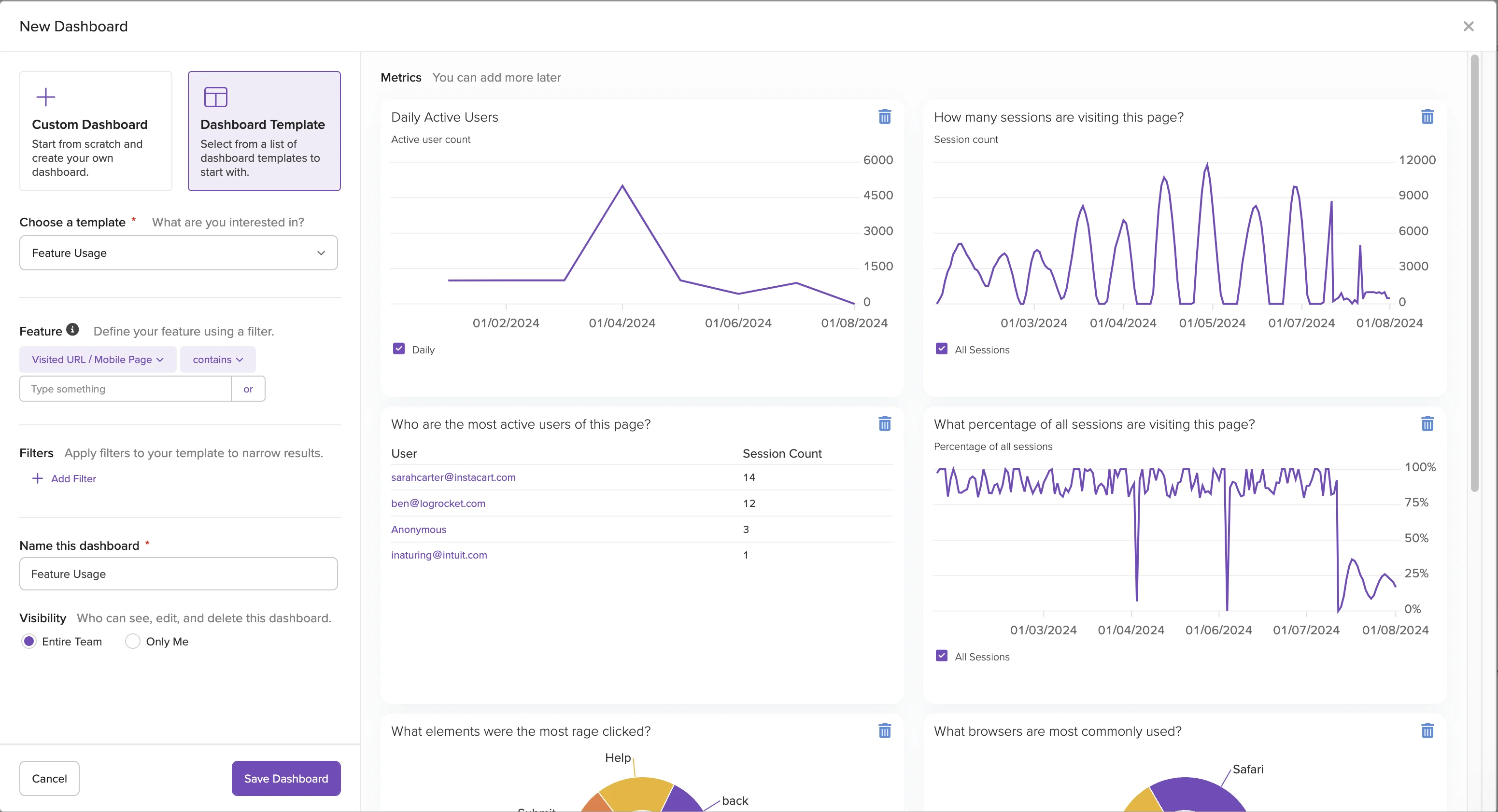
LogRocket offers more detailed user-centric error context than Sentry but may be less comprehensive for back-end error tracking.
Pricing
Pricing Model:
LogRocket uses a session-based pricing model, starting at $69/month for 10,000 sessions. Sentry, on the other hand, adopts an event-based pricing model, where costs increase based on the number of events and users, making it harder to predict expenses.
Cost Predictability: LogRocket provides a straightforward model where costs scale with session volume, ensuring better budgeting clarity. In contrast, Sentry's costs can become unpredictable as event counts grow, potentially leading to unexpected fees.
Value for Investment: LogRocket offers advanced features like session replay and AI-driven struggle detection even in its lower-tier plans, delivering significant value from the start. Sentry requires additional setup for features like incident management, which can increase the overall costs.
Scalability and Flexibility: LogRocket scales with your team's needs, maintaining a clear and manageable cost structure. Sentry's event-based pricing may not scale as effectively, particularly for teams with fluctuating event volumes.
Instrumentation and performance overhead
LogRocket's Mobile SDK optimizes app performance by minimizing its impact across several key metrics. It ensures screen capture on the main thread takes less than 16 milliseconds per frame, capturing the screen only once per second.
Bandwidth usage is kept low at an average of 10KB per second, while data is temporarily stored during offline periods. Disk usage is optimized through efficient I/O cycles, and app start times are categorized into Cold (<5s), Warm (<2s), and Hot (<1.5s) starts, adhering to Google's recommendations, with visual indicators in purple or red highlighting performance compliance.
For mobile sessions, LogRocket tracks real-time network throughput, memory usage every 10 seconds, and CPU usage above ~10%. It also flags frozen frames, indicating those taking over 700ms to render. This comprehensive monitoring provides granular insights into performance without compromising app responsiveness.
Data and Efficiency
Data Architecture
LogRocket's architecture is designed to provide a holistic view of user interactions and frontend performance metrics, making it ideal for tracking the user journey and UI/UX issues. It integrates seamlessly with frontend frameworks, enabling session replay and performance analysis.
In contrast, Sentry focuses on error tracking and event aggregation, excelling at debugging but lacking the detailed insights into user behavior and frontend performance that LogRocket provides. LogRocket's session replay and performance tracking offer a more comprehensive view of the user experience compared to Sentry's error-centric design.
Bandwidth Efficiency
LogRocket optimizes bandwidth by using protocol buffers (protobufs), a compact binary format that reduces data transmission size and keeps usage around 10KB per second during real-time recording. This makes it efficient in bandwidth-constrained environments.
Sentry, on the other hand, uses JSON, a text-based format that tends to be more verbose and consumes more bandwidth, especially when handling large volumes of data. LogRocket's use of protocol buffers ensures a more efficient, lower-bandwidth solution compared to Sentry's JSON-based transmission.
Device Storage Management
LogRocket manages device storage effectively by temporarily caching event data before uploading it, preventing excessive storage use and optimizing I/O cycles. This approach ensures the app's performance remains unaffected while reducing the strain on device storage.
In comparison, Sentry primarily focuses on error logs, and although it offers options for controlling data retention, it lacks the proactive storage management strategy that LogRocket employs for frontend performance data. LogRocket's caching system provides more efficient device storage management compared to Sentry's error storage.
Customizations and integrations
User Session Recording and Replay: LogRocket allows developers to record and replay user sessions, offering an in-depth view of user interactions and technical issues. This feature is valuable for reproducing and resolving customer-reported problems.
Quality Adjustment Through Circuit-Breakers: LogRocket automatically adjusts the recording quality in response to unusual behavior (e.g., overloaded Redux state, excessive console logs). This ensures that app performance is protected while still capturing necessary data.
Performance Optimization via Asynchronous Loading: LogRocket uses asynchronous loading of resources, which helps to avoid slowing down page load times. It loads a minimal, compressed script first, deferring the rest of the resources until essential components are ready.
Offloading Processing to Worker Threads: To minimize the presence on the main thread, LogRocket offloads most processing to a worker thread, allowing the app to remain responsive while still tracking key events like DOM mutations and user interactions.
Security and compliance
| Aspect | LogRocket | Sentry |
|---|---|---|
| Encryption | All network exchanges between the SDK and servers are encrypted with TLS, using SHA-256 ECDSA certificates and 256-bit ECC keys for secure data transfer. | AES-256bit encryption at rest; HTTPS TLS connections for data transmission. |
| RBAC | Role-based access controls are available in Professional and Enterprise plans | Basic RBAC with roles like Billing, Member, Admin, Manager, and Organization Owner. |
| Compliance | SOC II compliance, GDPR & CCPA compliance, PII audit, Data erasure | SOC2 Type I & II, HIPAA Attestation, ISO 27001. |
LogRocket differentiates itself with powerful session replay capabilities and detailed user interaction tracking, making it ideal for customer-facing applications.
4. Dynatrace
Dynatrace's all-in-one monitoring solution also offers an APM tool for automated observability for cloud-native services. It offers automated discovery and mapping, end-to-end observability, multiplatform app monitoring, and root-cause and impacts analysis.
It's a feature-packed, enterprise-ready monitoring solution, which often makes it quite pricey and painful to start with.
Key Features:
AI-driven root cause analysis:
Dynatrace leverages AI to identify the root causes of issues automatically, saving time in complex environments. Imagine your e-commerce platform suddenly faces a spike in latency. With Dynatrace, AI kicks in and instantly sifts through millions of metrics and events to pinpoint that a misconfigured microservice is causing a bottleneck at the payment gateway. In just minutes, Dynatrace not only identifies the root cause but also suggests fixes, like scaling up the payment service or addressing the misconfiguration.OpenTelemetry integration:
Dynatrace offers OpenTelemetry integration, allowing users to seamlessly collect, correlate, and analyze telemetry data across various services. This integration enables a more unified observability experience and helps streamline the troubleshooting process in complex, distributed systems.Automatic discovery and instrumentation:
Automatically detects and monitors applications, services, and dependencies without manual setup.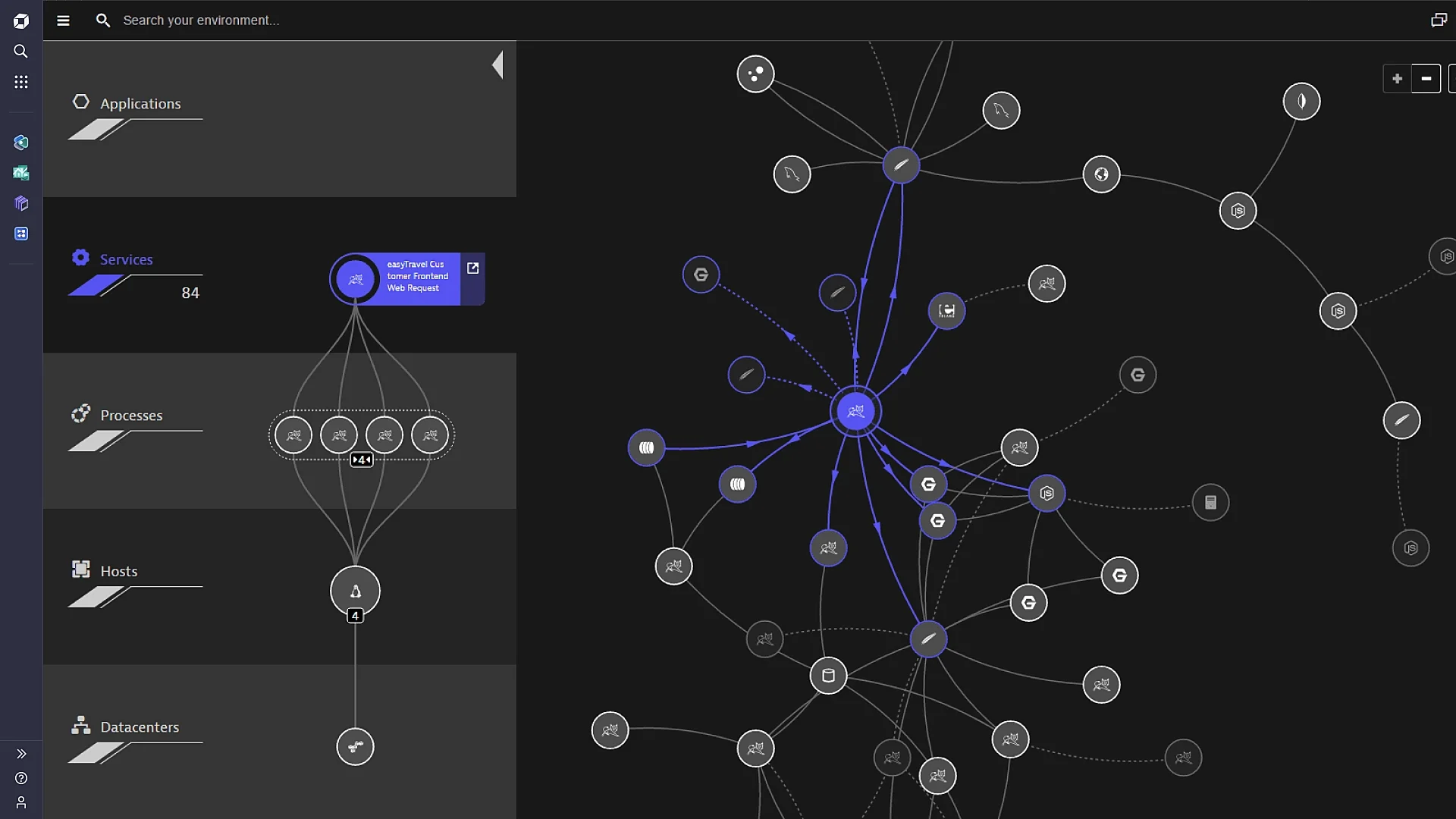
Automated Discovery with Dynatrace Here's how it works:
- Install OneAgent:
Install Dynatrace's OneAgent once per host. This is a single binary file containing specialized services tailored for your monitoring environment. - Automatic Discovery:
Within minutes, Dynatrace's Smartscape technology automatically detects all components and dependencies in your technology stack, including applications, services, processes, hosts, networks, and infrastructure. It gathers metrics on hardware, OS, and application processes. - Process Detection:
OneAgent detects all running processes on the host, including specific technologies like Java, Node.js, and .NET. It injects itself into these processes for detailed, code-level monitoring. - Automatic Instrumentation:
Based on the detected processes, OneAgent automatically activates instrumentation specifically for your stack. It injects tags into web application pages for real-user monitoring, tracking response times and performance in mobile and desktop browsers. - On-the-Fly Updates:
As new components are introduced, Dynatrace automatically instruments them in real-time, ensuring that all dependencies are continuously tracked and monitored. - Dynamic Topology:
The entire application topology, including relationships between components, is displayed visually in a dynamic and interactive way, providing full visibility into your environment.
- Install OneAgent:
Distributed tracing and code-level insights:
Provides in-depth tracing and diagnostics for distributed systems, offering actionable insights at the code level.Infrastructure monitoring:
Monitors the health and performance of cloud, on-premises, and hybrid infrastructures in real time.
| Pros | Cons |
|---|---|
| ✅ Comprehensive monitoring beyond just error tracking | ❌ Can be complex to set up and utilize fully |
| ✅ Powerful AI assistance for problem detection | ❌ Higher price point compared to dedicated error tracking tools |
| ✅ Suitable for large, complex environments | ❌ Setting up alerts can be complex and time-consuming |
Comparison to Sentry
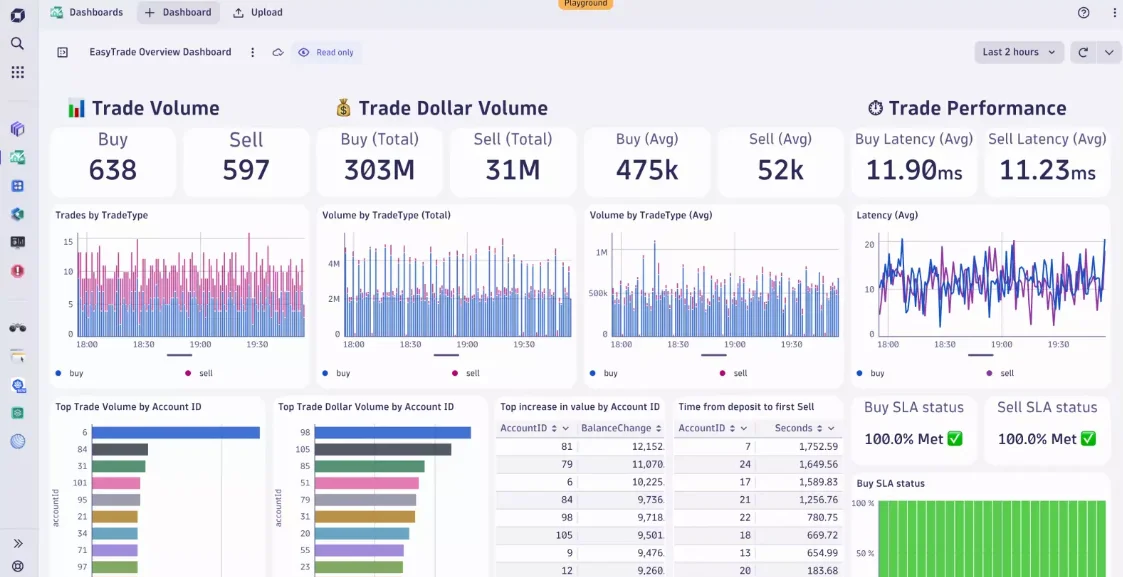
Dynatrace offers a more comprehensive monitoring solution but may be overkill for teams solely focused on error tracking.
Pricing
Pricing Model:
Dynatrace starts at $0.08 per hour for 8 GiB hosts, scaling with resource usage. This pay-as-you-go model ensures that costs align predictably with monitoring needs.
In contrast, Sentry uses an event-based pricing model, starting at $29/month for 100,000 events, with costs rising as event volume increases.Cost Predictability and Scalability:
Dynatrace offers detailed transparency and scalability, making it ideal for teams managing infrastructure, cloud platforms, and containers. Its costs remain aligned with resource usage.
Sentry provides a simpler pricing model but lacks granular control over usage, which can result in unpredictable costs as event volumes grow.Use Case Suitability:
Dynatrace is better suited for teams that need comprehensive infrastructure and application-level observability with predictable cost growth. On the other hand, Sentry focuses on application monitoring but may become less cost-effective for teams with high user volumes or frequent events.
Instrumentation and performance overhead
Instrumentation:
Dynatrace provides full-stack instrumentation with AI-powered insights through its OneAgent, automatically detecting and monitoring all components. This ensures comprehensive visibility across both front-end and back-end systems with minimal configuration.
In comparison, Sentry focuses on error tracking with lightweight instrumentation, introducing minimal performance overhead, but its scope is limited to error management rather than full-stack observability.Performance Overhead:
Dynatrace, while offering AI-driven optimizations for resource usage, may slightly increase resource consumption due to its comprehensive monitoring across the entire environment.
Sentry, on the other hand, is designed for error tracking and lightweight monitoring, which results in minimal overhead but with a narrower focus compared to Dynatrace's full-stack coverage.
Data Architecture
Data Ingestion and Storage:
Dynatrace uses a proprietary architecture designed for large-scale data ingestion and AI-driven insights, offering real-time monitoring across distributed environments.
Sentry, on the other hand, relies on ClickHouse for columnar storage and focuses on error tracking and event data. While effective for smaller setups, it is less scalable for full-stack observability.Data Management and Flexibility:
Dynatrace handles various telemetry types (metrics, logs, traces, events) with real-time analysis and AI-powered anomaly detection, making it ideal for complex infrastructures.
Sentry focuses on error and event data with efficient log analysis and automated data parsing but lacks the flexibility needed for full-stack observability.Handling Large-Scale Environments:
Dynatrace is built for enterprise-scale environments, offering AI-powered insights and scalable monitoring of complex IT systems.
Sentry is better suited for smaller to medium-sized environments, excelling at error tracking but not designed for full-stack observability at large scale.Real-time Monitoring and Latency:
Dynatrace provides real-time monitoring with low latency and AI-driven insights, ensuring proactive detection and resolution of issues.
Sentry offers real-time error tracking but focuses on event data, lacking the comprehensive performance monitoring found in Dynatrace.
Customizations and integrations
Integration Capabilities:
Dynatrace offers over 600 integrations, making it ideal for large enterprises with complex infrastructures. It connects seamlessly with various monitoring tools, observability platforms, and DevOps tools like AWS and Kubernetes. In contrast, Sentry focuses on developer-oriented integrations with platforms like GitHub and Jira, excelling in error tracking but providing fewer options than Dynatrace.Customization and Flexibility:
Dynatrace offers extensive customization, enabling tailored dashboards, alerts, and reports, along with automatic dependency mapping for complex environments. This makes it ideal for enterprise-scale observability. In contrast, Sentry provides basic customization features like custom tags and issue grouping, focusing on quick issue resolution rather than extensive monitoring capabilities.Focus on Enterprise vs. Developer Needs:
Dynatrace is tailored for enterprise-scale environments, offering comprehensive visibility across infrastructure, applications, and security systems. It handles vast amounts of data and maps complex dependencies, making it ideal for large organizations managing diverse IT systems and infrastructure.
Sentry, by contrast, caters to developer-specific observability. With its simpler setup and focus on real-time error tracking and resolution, Sentry is better suited for teams needing fast, efficient debugging for application issues.Automatic Dependency Mapping and Advanced Insights:
Dynatrace's automatic dependency mapping provides a comprehensive view of the application and infrastructure environment. It automatically identifies and visualizes the interactions between services, which is especially valuable for organizations with complex, multi-cloud, or hybrid environments.
Sentry does not offer the same level of automatic dependency mapping. It focuses more on error tracking, performance insights, and trace visibility. While it provides deep insights into errors and transactions, Sentry lacks the enterprise-level visibility into infrastructure dependencies that Dynatrace offers.
Security and compliance
| Aspect | Sentry | Dynatrace |
|---|---|---|
| Encryption | AES-256bit encryption at rest; HTTPS TLS connections for data transmission. | End-to-end encryption, masking data at capture, storage, and display. |
| RBAC | Basic RBAC with roles like Billing, Member, Admin, Manager, and Organization Owner. | Advanced RBAC to account, environment and management zones |
| Compliance | SOC2 Type I & II, HIPAA Attestation, ISO 27001. | SOC 2, GDPR, HIPAA, |
Dynatrace provides enterprise-grade monitoring with AI-powered insights, ideal for complex infrastructures requiring comprehensive observability.
5. AppSignal
AppSignal is a powerful performance monitoring and error tracking tool. Offering a combination of detailed performance analysis and host metrics monitoring, it delivers clear and actionable insights for developers. AppSignal stands out with its seamless integration into Ruby on Rails and Elixir/Phoenix frameworks, making it particularly useful for developers working within these ecosystems.
Key Features:
- Automatic error grouping and prioritization: AppSignal intelligently groups similar errors together, making it easier to identify and resolve issues while prioritizing critical errors for faster resolution.
- Performance impact analysis: The tool provides detailed insights into the performance bottlenecks in both frontend and backend, allowing you to track issues that could impact your application's responsiveness.
- Host metrics monitoring: AppSignal enables you to monitor the performance of the servers and infrastructure running your applications, offering insights into resource usage such as CPU and memory.
- Custom metrics and dashboards: Users can create custom dashboards and define specific metrics to monitor based on their unique business and performance needs, ensuring relevant data is always in sight.
| Pros | Cons |
|---|---|
| ✅ Deep integration with Ruby on Rails and Elixir/Phoenix | ❌ Limited language support such as on macOS/OSX, limited distributions of Linux and FreeBSD, compared to some alternatives. |
| ✅Clear, actionable insights for developers | ❌ May lack some advanced features for large enterprise use cases such as providing a granular RBAC |
| ✅ Anomaly detection for proactive issue resolution | ❌ Its customization options and integrations are more limited |
Comparison to Sentry

AppSignal provides error tracking similar to Sentry but with a stronger focus on performance monitoring and optimization. It is particularly beneficial for developers working in Ruby, Elixir, and JavaScript environments, offering deep integrations that enhance workflow.
Pricing
- Pricing Model AppSignal offers flat, predictable pricing with no hidden costs, making budgeting straightforward for teams. All plans include metric dashboards and access to free support from real humans. Sentry follows a tiered pricing structure, where costs increase with additional features or overages. Premium features like metric dashboards are available only in higher-tier plans, such as Business and Enterprise.
- Cost Transparency AppSignal stands out for its transparent pricing and relaxed upgrade policy, avoiding sudden cost increases. The 14-day APM trial includes all features, providing a risk-free way to evaluate the platform. Sentry's pricing can escalate by over 200% for businesses moving beyond the "Teams" plan, with added charges for premium features and overages, making cost management more complex.
- Customer Experience AppSignal focuses on customer-friendly perks, including free stroopwafels and personalized support, which enhances the overall value of its service. Sentry provides robust application monitoring but adds complexity with its premium features and pricing structure.
Instrumentation and performance overhead
- Dashboards AppSignal provides automated dashboards that are generated instantly based on the data sent, available with all plans whereas sentry offers limited template dashboards, but these are restricted to its Business and Enterprise plans.
- Deployment Markers AppSignal ensures universal support with an easy setup for deployment markers. Sentry requires posting to an API endpoint for deploying markers, which adds complexity.
- Namespace Monitoring AppSignal simplifies namespace monitoring with a straightforward setup available across all plans whereas sentry uses tags to filter metric data for namespace monitoring, making it more complex.
- Performance Analysis AppSignal focuses on application-level performance analysis, allowing developers to pinpoint slowdowns and inefficiencies. It provides helpers to display relevant data alongside performance metrics for root cause identification. It also offers automatic instrumentation to monitor requests and identify slow requests without complex manual setup. With sentry, it primarily offers error tracking and performance monitoring but lacks the same level of application-specific helpers and automatic instrumentation for performance analysis as AppSignal.
Data Architecture
- Data Storage and Scalability AppSignal uses cloud-hosted storage optimized for real-time analysis, focusing on smaller to mid-sized applications. It scales well but is geared more towards performance insights than complex data queries. Sentry's distributed architecture scales with data, offering both self-hosted and cloud options. The cloud-hosted version is scalable but may struggle with large datasets, especially for complex queries.
- Data Retention and Export AppSignal offers automatic export to S3-compatible storage for long-term retention, useful for compliance and extended analysis. Sentry allows customizable retention periods and, for long-term storage, requires external systems. Self-hosted options offer more flexibility.
- Data Query and Analysis AppSignal focuses on real-time insights with simple dashboards, best for frontend performance and error tracking. Sentry excels at event and error tracking but offers limited querying for deep analysis, focusing more on real-time detection and trace analysis.
- Handling Large-Scale Environments AppSignal is ideal for smaller environments, focusing on simplicity and real-time performance insights. Sentry is scalable for large environments but may need extra resources or integrations for complex data analysis at scale.
Customizations and integrations
- Framework-Specific Integrations AppSignal specializes in Ruby on Rails and Elixir/Phoenix integrations, offering tailored performance insights and error tracking. It also supports custom metrics via APIs. Sentry supports a broader range of platforms but lacks the same framework-specific customization that AppSignal provides for Ruby on Rails and Elixir/Phoenix.
- Security and Access Management AppSignal integrates with SAML SSO for secure enterprise-level access. Sentry supports SSO but may require more configuration, and its external security system integration is not as seamless as AppSignal's.
- Anomaly Detection AppSignal includes host monitoring and anomaly detection by default, helping teams track performance issues easily. Sentry offers change alerts for anomaly detection, but these are limited to higher-tier plans (Business and Enterprise).
- Setup and Configuration AppSignal features a simplified setup with automatic metric dashboards, background job monitoring, and easy namespace configuration, streamlining the process. Sentry requires more integrations and configurations for performance monitoring, making the setup process more complex compared to AppSignal.
Security and compliance
| Aspect | Sentry | AppSignal |
|---|---|---|
| Encryption | AES-256bit encryption at rest; HTTPS TLS connections for data transmission. | End-to-end encryption |
| RBAC | Basic RBAC with roles like Billing, Member, Admin, Manager, and Organization Owner. | Basic RBAC |
| Compliance | SOC2 Type I & II, HIPAA Attestation, ISO 27001. | GDPR, HIPAA, ISO:27001, ISO:9001 |
While AppSignal offers end-to-end encryption and GDPR compliance, it may not meet the specific security or compliance needs of larger enterprises requiring more granular controls, such as detailed role-based access (RBAC) or compliance certifications like SOC 2.
AppSignal shines in Ruby and Elixir environments, offering streamlined performance monitoring with clear, actionable insights for developers.
6. BugSnag
BugSnag is a comprehensive error monitoring and stability management tool, supporting a wide range of platforms and languages. It provides automatic error detection and advanced debugging tools tailored for JavaScript applications, including React, Vue, and Angular frameworks.
BugSnag is known for its strong focus on mobile app error tracking (iOS and Android) and offers robust features for release tracking, diagnostics, and stability scoring, making it a valuable tool for maintaining app reliability.
Key Features:
- Automatic error grouping and prioritization: It automatically groups related errors and prioritizes them based on severity, making it easier to manage and resolve issues.
- Release tracking and stability scores: It provides insights into the stability of your app by assigning a stability score based on the error rates during a specific release, helping teams track the health of their app over time.
Stability Score = 100 - (Unhandled Errors / Sessions x 100) - Breadcrumbs for error reproduction: It collects breadcrumbs, which are events or logs that provide context before an error occurred, enabling developers to reproduce and diagnose issues faster.
- Integration with issue trackers and communication tools: It integrates seamlessly with tools like Jira, Slack, GitHub, and others, allowing teams to streamline their workflows and respond to issues more efficiently.
| Pros | Cons |
|---|---|
| ✅ Strong support for mobile platforms (iOS, Android) | ❌ Less emphasis on performance monitoring compared to some alternatives |
| ✅ Clear stability scoring for measuring app health | ❌ Can become costly for high-volume applications |
| ✅ Detailed diagnostic information for quick debugging | ❌ It may lack the advanced performance monitoring capabilities of other tools like SigNoz. |
Comparison to Sentry
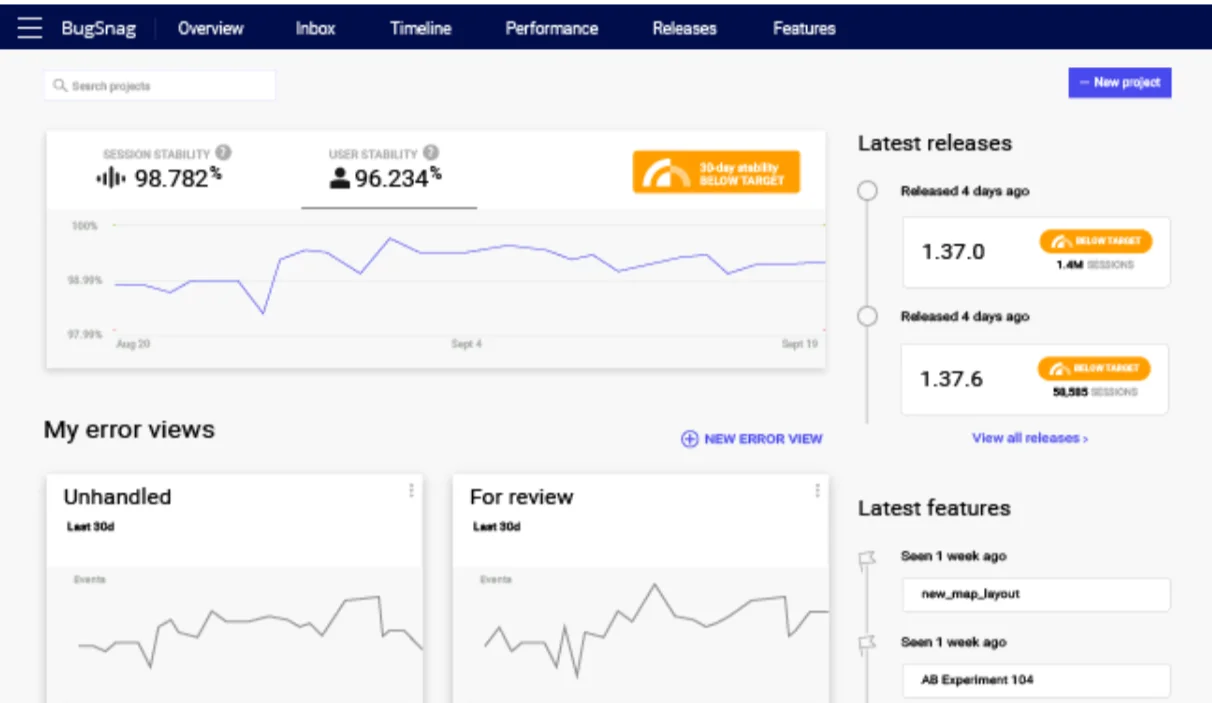
BugSnag offers similar core functionality to Sentry, particularly for error tracking, but with a stronger emphasis on mobile app support and stability management.
Pricing
- Pricing Model BugSnag offers a flexible pricing model, allowing users to manage daily event quotas and apply rate limiting to avoid unexpected charges. Sentry uses a tiered pricing structure, where costs increase with event volume, leading to potential overage fees or mandatory upgrades.
- Trial and Flexibility BugSnag offers a 14-day free trial with full access to all features, giving businesses a risk-free opportunity to explore its offerings. Sentry provides free trials for certain tiers, but its pricing can escalate with higher event counts or premium features.
- Cost Transparency BugSnag is known for transparent invoicing and flexible payment options, with discounts for annual plans. Sentry's tiered pricing and overage policies can lead to complex billing, resulting in unforeseen additional costs.
- Customer-Focused Benefits BugSnag prioritizes customer-friendly features like customizable event handling and quota management. Sentry's tiered pricing and overage charges may be less favorable for teams with fluctuating event volumes.
Instrumentation and performance overhead
- Performance Data Management BugSnag uses an efficient system with managed and unmanaged spans. Managed spans adjust dynamically for smooth performance monitoring, while unmanaged spans provide control over sampling rates. Sentry's dynamic sampling can lead to trace incompleteness and dropped events, especially under high traffic or frequent sampling adjustments.
- Sampling Strategy BugSnag offers precise control over sampling rates, ensuring optimal performance with minimal latency. Sentry's dynamic sampling strategy aims to maintain trace completeness but can introduce additional overhead, affecting efficiency.
- Latency and Efficiency BugSnag prioritizes minimal setup and efficiency, designed for teams needing low-latency performance without complexity. Sentry's reliance on stored events and dynamic sampling can increase overhead, making it less efficient in low-latency environments.
- Trace Completeness BugSnag's simplified sampling strategies help maintain consistent and complete performance data. Sentry aims for trace completeness, but rate limiting and dropped events can impact data integrity.
Data Architecture
- Data Sampling and Performance BugSnag uses sampled data, like percentiles (e.g., P90), balancing performance insights with system efficiency. It optimizes error tracking without overwhelming the system. Sentry relies on unsampled and stored events, offering granular analysis but at the cost of increased system overhead and potential inefficiency with large datasets.
- Efficiency and Resource Management BugSnag's focused architecture uses quotas and sampling strategies to manage resources efficiently, keeping the system streamlined. Sentry's reliance on stored events for deep queries can lead to greater resource consumption, which may affect performance, particularly in large-scale environments.
- Complexity and Flexibility BugSnag's simpler, efficient architecture provides more flexibility and reduces data management complexity. Sentry offers detailed analysis but may become more complex due to its need for storage and increased resource demands, limiting flexibility.
- Scalability and Data Management BugSnag's sampled data approach ensures scalability without overloading the system, keeping performance analysis efficient. Sentry may face scalability challenges as data volume increases, requiring more resources to maintain performance.
Customizations and integrations
- Integration Options Sentry provides a wide range of integrations with platforms like Jira, GitHub, and Slack, making it ideal for full-stack monitoring and seamless workflows. BugSnag offers simpler integrations via a JSON-based API, focusing on streamlined error tracking but with fewer integration options compared to Sentry.
- Customization Options Sentry allows for extensive customization, such as custom tags and detailed trace visibility, enabling teams to tailor monitoring to their needs. BugSnag offers basic customization, including filters for user behavior and device type, but lacks the extensive flexibility of Sentry.
- Setup Complexity Sentry's setup is more complex due to its wide array of features and customization options. BugSnag is known for its simplicity, offering a quick and easy setup for teams that prefer a straightforward solution.
Security and compliance
| Aspect | Sentry | Bugsnag |
|---|---|---|
| Encryption | AES-256bit encryption at rest; HTTPS TLS connections for data transmission. | uses HTTPS and Transport Layer Security (TLS) to encrypt all communications between users and servers by default. Customer data is also encrypted at rest, with automatic encryption applied before data is written to disk. |
| RBAC | Basic RBAC with roles like Billing, Member, Admin, Manager, and Organization Owner. | Supports role-based access control with customizable roles available in higher-tier plans. |
| Compliance | SOC2 Type I & II, HIPAA Attestation, ISO 27001. | ISO 27001, ISO 27017, ISO 27018, EU GDPR, CCPA, SOC 1, SOC 2 and SOC 3 |
Bugsnag offers strong data encryption and compliance with GDPR, though its RBAC features are more limited, which may be a consideration for larger teams or those with stricter security requirements.
BugSnag excels in mobile app error tracking with powerful stability scoring and diagnostics features, making it ideal for mobile-first development teams.
7. New Relic
New Relic is a leading observability platform that provides a full suite of monitoring and performance management tools for applications, infrastructure, and digital experiences. It offers a comprehensive solution with capabilities for Application Performance Monitoring (APM), Kubernetes monitoring, ML model monitoring, log management, synthetic monitoring, and more. Known for its robust APM features, New Relic allows businesses to visualize and optimize their stack performance while delivering powerful error tracking, real-time insights, and AI-powered anomaly detection.
Key Features:
- Full-stack observability (errors, metrics, logs, traces): New Relic provides a unified platform to monitor every layer of your stack, integrating application performance, error tracking, infrastructure metrics, and logs in one place.
- AI-powered anomaly detection: Leverages machine learning to automatically detect anomalies and performance issues, helping teams proactively address potential problems.
- Distributed tracing and service maps: New Relic's distributed tracing enables users to track requests across services, and service maps provide clear visualizations of application dependencies.
- Custom dashboards and alerting: Create personalized dashboards for your team, set up custom alerts, and get notified when key metrics or performance indicators fall outside defined thresholds.
| Pros | Cons |
|---|---|
| ✅ Integrates with SAP, providing extensive monitoring capabilities for enterprise clients. | ❌ Can be complex to set up and fully utilize |
| ✅ Powerful query language for data analysis | ❌ Pricing can escalate quickly with data volume |
| ✅ Extensive integrations with cloud services and DevOps tools | ❌ Extensive data collection can overwhelm customers, making pinpointing and prioritizing insights tricky. |
Comparison to Sentry
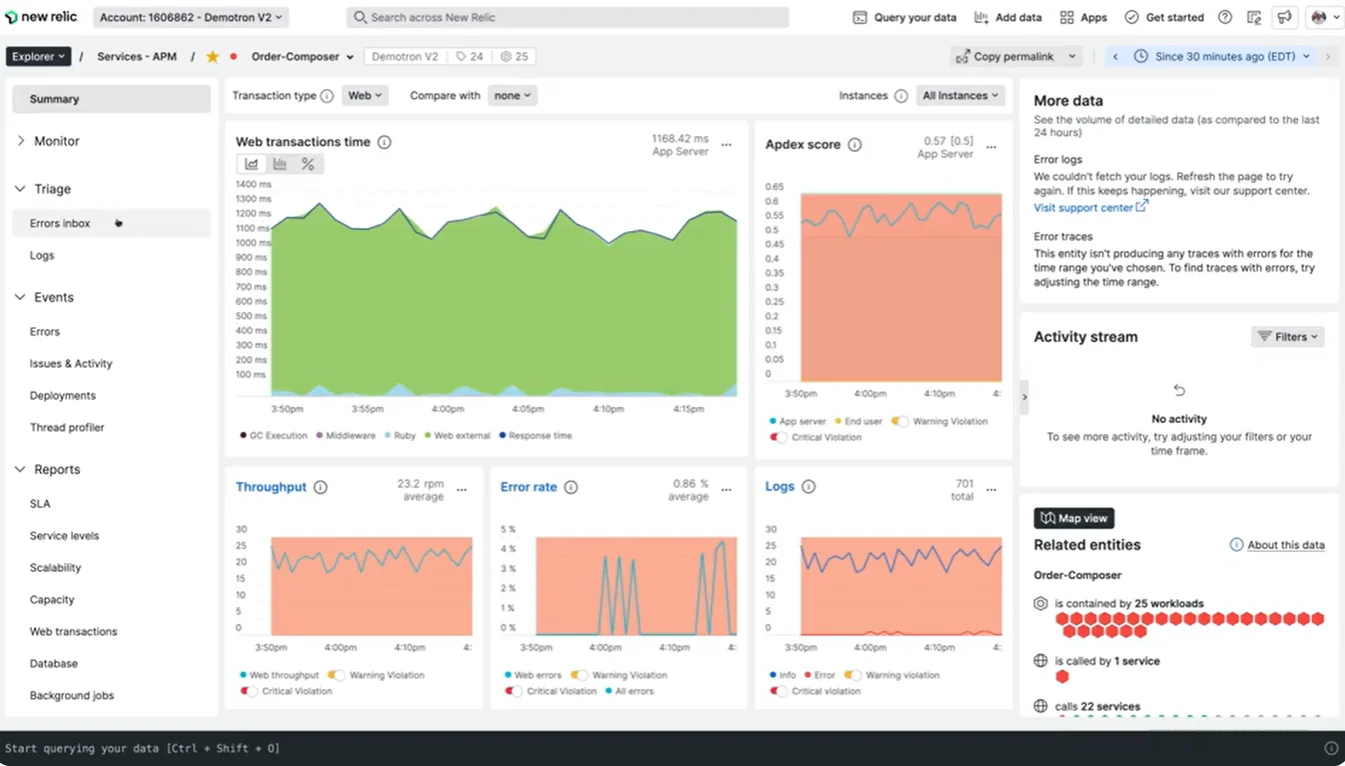
New Relic provides a more comprehensive observability solution than Sentry, with added complexity and a broader range of features. While Sentry focuses primarily on error tracking, New Relic offers full-stack observability, including monitoring, APM, and detailed infrastructure analysis.
Pricing
- Pricing Model New Relic offers 100 GB of free data ingestion per month, charging
0.35 per GB** for additional data. Paid plans start at **49 per month with a predictable pricing structure. Sentry uses an event-based pricing model, charging separately for features like errors, spans, replays, and attachments, leading to potential complexity in cost estimation. - Cost Predictability New Relic's pricing is straightforward, based on data usage, making it ideal for large-scale ingestion and easier to scale. Sentry's pricing is unpredictable, as it charges for each event and feature, potentially increasing costs as usage grows.
- Plan Flexibility and Scaling New Relic offers unlimited platform users on the Pro plan for $349 per year per user, making it attractive for teams needing more users without additional costs. Sentry's pricing is based on usage volume, leading to unpredictable costs for teams with fluctuating data or events.
Instrumentation and performance overhead
- Performance Overhead New Relic offers detailed APM capabilities with extensive monitoring, but this can introduce performance overhead, especially in resource-constrained environments. It is more suitable for scenarios where in-depth monitoring is prioritized. Sentry, focused on error tracking, has a lower performance impact, making it ideal for environments where error management is the primary concern.
- Setup Complexity New Relic requires a longer setup due to its complex and comprehensive monitoring features, which may be challenging for teams with limited resources. Sentry offers a simpler setup process, with a focus on error tracking, allowing quick implementation without complex integrations.
- Error Grouping New Relic automatically groups errors based on factors like stack traces and HTTP requests, providing a comprehensive view of errors in the context of the application's performance. Sentry offers custom grouping rules, providing greater flexibility for teams to tailor error management based on their specific application needs.
Data Architecture
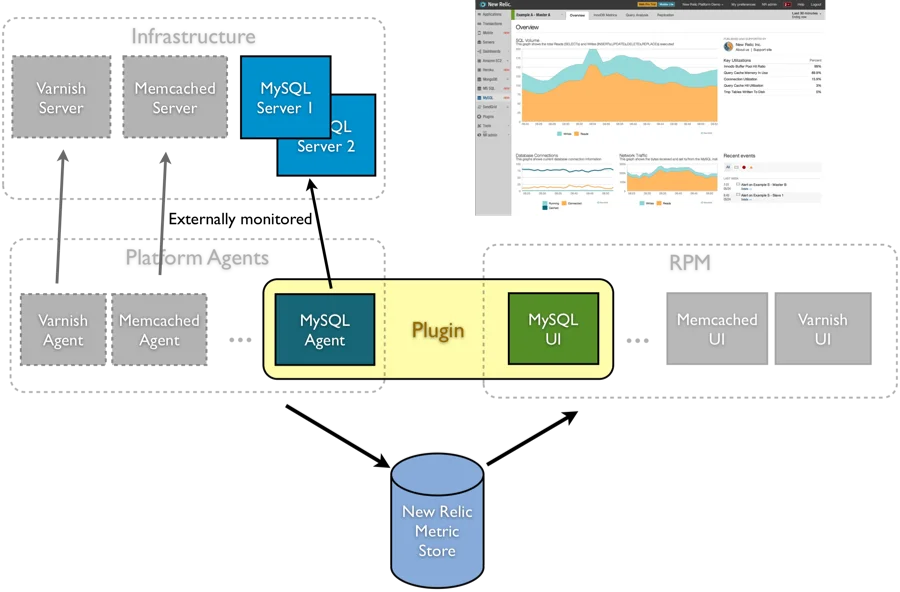
- Event Sampling and Data Integrity New Relic uses event limits and sampling to optimize data ingestion and ensure data integrity, especially when agents can't connect or reporting limits are reached. It includes tools like
EXTRAPOLATEto maintain accuracy during limited data availability. Sentry applies dynamic sampling to preserve trace completeness, but under rate limits, partial traces may result, affecting full trace analysis accuracy. - Control and Flexibility New Relic provides precise control over agent configurations, offering flexibility to handle large volumes of telemetry data in complex, high-traffic systems. Sentry, with its reliance on dynamic sampling and client-side filtering, offers less flexibility and control compared to New Relic, especially in large-scale environments.
- Scalability and Flexibility in Handling Volumes New Relic handles large volumes of telemetry data with high scalability, integrating traces, metrics, logs, and events for comprehensive observability. Sentry, focused mainly on error tracking, is scalable for error and performance monitoring but lacks broader telemetry capabilities.
- Full-Stack Observability New Relic excels at full-stack observability, integrating multiple data sources for unified insights across the application stack, making it ideal for monitoring complex systems. Sentry focuses on error tracking and event monitoring, with less emphasis on full-stack observability and broader telemetry analysis.
Customizations and integration
- Range of Integrations New Relic supports a wide range of integrations with cloud services, DevOps tools, and third-party applications, offering comprehensive insights across the system. Sentry, while offering some integrations, focuses mainly on error tracking and performance monitoring, lacking the variety seen in New Relic.
- Customization Capabilities New Relic offers deep customization through NRQL (New Relic Query Language), enabling tailored dashboards and alerts, though it can be complex for beginners. Sentry provides a simpler approach with fewer customization options, focusing on easy error tracking and monitoring.
- Custom Dashboards and Alerts New Relic allows advanced customization for dashboards and alerts, providing flexibility for teams needing detailed system insights. Sentry offers predefined dashboards and alerts with limited customization, focusing more on error tracking.
Security and compliance
| Aspect | Sentry | New Relic |
|---|---|---|
| Encryption | AES-256bit encryption at rest; HTTPS TLS connections for data transmission. | New Relic secures data with TLS 1.3 encryption in transit for all customers and automatically encrypts data at rest using AES-256 in AWS and Azure. FIPS 140-2 compliance is available upon request, with unique encryption keys that are destroyed when instances stop. |
| RBAC | Basic RBAC with roles like Billing, Member, Admin, Manager, and Organization Owner. | Advanced RBAC with built-in base roles (Admin, User, Restricted User) and easy-to-manage, fine-grained permissions through custom and New Relic-managed add-on roles. |
| Compliance | SOC2 Type I & II, HIPAA Attestation, ISO 27001. | FedRAMP, HIPAA, HITRUST, ISO 27001, PCI DSS, SOC 2, TISAX |
Learn more about new relic vs sentry.
New Relic offers comprehensive observability with powerful querying capabilities and extensive integrations, suited for organizations needing full-stack monitoring.
8. Raygun
Raygun provides powerful error tracking, crash reporting, and performance monitoring with a strong emphasis on delivering actionable insights for developers. It enables real-time tracking of web and mobile applications, offering deep diagnostic capabilities to help teams resolve performance issues and application crashes quickly. Raygun integrates real user monitoring (RUM) and session tracking, giving teams detailed insights into user experiences and the impact of performance issues.
Key Features:
- Real user monitoring and session tracking: Raygun captures and analyzes real user interactions, providing insights into the actual performance experience for users and how it affects their journey across applications.
- Error grouping and prioritization: Automatically groups errors and crashes to avoid overwhelming developers with duplicate issues and allows prioritization based on severity or user impact.
- Deployment tracking: Track the impact of new releases by linking errors and crashes to specific deployments, making it easier to pinpoint the cause of issues after a release.
- Multi-language and platform support: Raygun supports a wide range of programming languages and platforms, including JavaScript, .NET, Java, iOS, and Android, ensuring comprehensive monitoring coverage across your stack.
| Pros | Cons |
|---|---|
| ✅ Intuitive interface for quick issue identification | ❌ Can become costly for high-volume applications |
| ✅Detailed user session data for context | ❌ Some advanced features limited to higher-tier plans |
| ✅ Strong support for mobile and web applications | ❌ When dealing with a large number of exceptions, it can be challenging to find specific errors without additional filtering options |
Comparison to Sentry

Raygun and Sentry provide similar core functionality, focusing on error tracking and performance monitoring, but Raygun adds a stronger emphasis on real user monitoring (RUM) and session tracking, making it ideal for teams focusing on end-user experience.
Pricing
- Pricing Model Raygun uses a tiered pricing model based on error/exception events tracked per month, allowing flexibility based on event volume. Sentry follows a user seat-based pricing model, with costs increasing based on users and events tracked. It offers a free tier, but costs can escalate as applications grow.
- Cost Predictability Raygun's tiered model provides more control over costs, especially for high-traffic applications, though it can still get expensive. Sentry's pricing can be unpredictable as it scales with users and events.
- Scalability Raygun is better suited for teams focusing on user session tracking and crash reporting at scale, benefiting from its tiered system. Sentry's pricing may rise rapidly as the number of users and events increases.
Instrumentation and performance overhead
- Lightweight and Non-Intrusive Instrumentation Raygun is designed to be lightweight and non-intrusive, minimizing performance impact while tracking errors and performance. Sentry provides lightweight instrumentation but places more emphasis on backend performance, which may result in slightly higher overhead than Raygun's frontend-focused approach.
- Performance Overhead Raygun has low overhead, especially in real user monitoring (RUM) and frontend applications, allowing real-time performance tracking with minimal impact. Sentry's comprehensive APM for backend monitoring can introduce higher performance overhead, particularly in environments prioritizing frontend performance.
- Frontend and Mobile Monitoring Raygun offers browser and mobile monitoring, providing insights into performance issues on both web and mobile platforms. Sentry focuses more on backend monitoring and error tracking, with less emphasis on frontend or mobile-specific tracking.
- Real-Time Tracking and Performance Bottlenecks Raygun excels at real-time tracking of performance bottlenecks, using RUM for insights into frontend issues. Sentry also monitors performance but is more focused on server-side and backend performance, rather than frontend tracking.
Data Architecture
- Real-Time Data Collection and Storage Raygun offers real-time data collection and storage, providing instant feedback on issues for faster troubleshooting and resolution. Sentry also tracks errors in real-time but focuses more on event data and error management, lacking the depth of performance metrics for frontend applications that Raygun provides.
- Error Grouping and Prioritization Raygun features automatic error grouping and prioritization, helping teams quickly identify and resolve critical issues, especially those impacting user experience. Sentry offers error grouping but has less focus on prioritization and frontend performance, making Raygun more specialized for managing user experience-related issues.
- Real User Monitoring (RUM) and Session Tracking Raygun includes RUM and session tracking, providing deep insights into the user experience and performance, ideal for optimizing the frontend and tracking user interactions. Sentry is more focused on error tracking and event data, with less emphasis on RUM and session tracking, making it less integrated for user experience metrics than Raygun.
Customizations and integrations
- Integrations with Tools Raygun integrates with tools like Slack, Jira, and GitHub, enhancing its functionality for teams using multiple platforms for project management. Sentry also integrates with similar tools but doesn't focus as much on frontend performance or real user monitoring (RUM), making its integrations less specialized in these areas.
- Customization in Error and Performance Tracking Raygun offers detailed tracking for frontend performance and RUM, providing a more tailored approach to error analysis and insights into user interactions. Sentry supports performance monitoring but doesn't offer the same level of customization for frontend performance or user experience as Raygun.
- Deployment Tracking and Release Correlation Raygun includes deployment tracking, allowing teams to correlate errors with specific releases and identify issues introduced by new deployments. Sentry lacks dedicated deployment tracking, making it less optimized for release correlation compared to Raygun.
- Data Retention and Privacy Raygun retains error event data for 180 days by default, with the option to extend retention as needed. Sentry offers self-hosting options, giving organizations full control over data retention and privacy, which is ideal for strict data governance requirements.
Security and compliance
| Aspect | Sentry | Raygun |
|---|---|---|
| Encryption | AES-256bit encryption at rest; HTTPS TLS connections for data transmission. | Provides 256-bit data encryption and private source maps |
| RBAC | Basic RBAC with roles like Billing, Member, Admin, Manager, and Organization Owner. | Supports role-based access control (RBAC) in higher-tier plans |
| Compliance | SOC2 Type I & II, HIPAA Attestation, ISO 27001. | HIPAA, GDPR, CCPA, and PCI |
While Raygun offers end-to-end encryption and GDPR compliance, it may not meet the specific security or compliance needs of larger enterprises requiring more granular controls, such as detailed role-based access (RBAC) or compliance certifications like SOC 2.
Raygun combines powerful error tracking with real user monitoring, providing deep insights into user experience and application performance.
9. Jaeger
Jaeger is an open-source, end-to-end distributed tracing system designed primarily for monitoring and troubleshooting microservices architectures. Jaeger enables users to perform root cause analysis, dependency analysis, and optimize system performance by providing deep insights into microservices interactions. Jaeger's distributed tracing capabilities are designed to handle large-scale, high-throughput environments with support for NoSQL databases like Cassandra and Elasticsearch.
Note: Since 2022, Jaeger has deprecated its native SDKs in favor of OpenTelemetry, enabling it to receive trace data from OpenTelemetry SDKs. This change makes Jaeger a more flexible and future-proof solution for tracing applications within modern observability stacks. OpenTelemetry has become the standard for instrumenting distributed systems and integrates seamlessly with Jaeger for comprehensive trace collection.
Key Features:
- Distributed context propagation: Jaeger connects data across different components, allowing the creation of complete end-to-end traces that offer a clear view of how microservices interact.
- Dependency analysis: Provides insights into service dependencies and how issues in one service might affect others in the architecture.
- Root cause analysis: Helps identify performance bottlenecks and service issues by analyzing trace data.
- Data mining for performance and process bottlenecks: Helps teams discover where performance issues or inefficiencies exist in a distributed system.
| Pros | Cons |
|---|---|
| ✅ Deep insights into microservices interactions | ❌Primarily focused on tracing; may need additional tools for comprehensive error tracking |
| ✅ High scalability for large, distributed systems | ❌ Requires more setup and maintenance compared to SaaS solutions |
| ✅ Active open-source community | ❌ May require significant infrastructure and operational overhead |
Comparison to Sentry
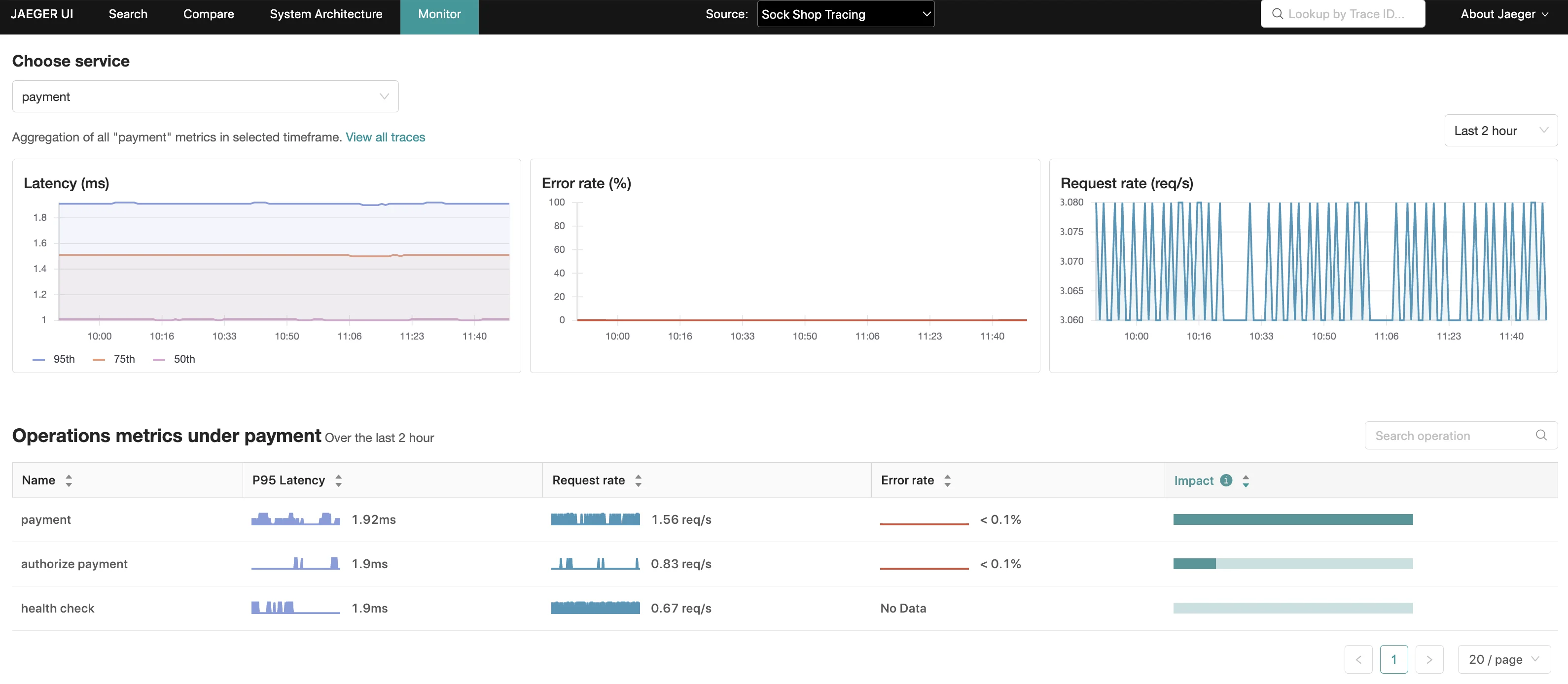
Jaeger and Sentry both provide monitoring and observability tools, but they serve different purposes and can complement each other in a comprehensive observability strategy. Jaeger focuses on distributed tracing and provides detailed insights into the flow of requests and dependencies across services, making it ideal for microservices architectures. On the other hand, Sentry primarily focuses on error tracking and performance monitoring, capturing individual error events and anomalies.
Pricing
- Pricing Model Jaeger is open-source and free to use, but costs come from infrastructure, deployment, and maintenance (e.g., storage with Cassandra or Elasticsearch). Sentry follows a subscription-based model, where costs are based on the number of seats or events processed, offering a fully managed service.
- Cost Predictability Jaeger has flexible costs tied to infrastructure and maintenance, but scaling and data retention add complexity. Sentry offers more predictable and scalable pricing, tied directly to users or events processed.
- Operational Overhead Jaeger requires teams to handle deployment, maintenance, and storage, leading to higher operational overhead. Sentry is a fully managed service, reducing operational complexity but potentially increasing costs as usage grows.
Instrumentation and performance overhead
- Sampling and Data Collection Jaeger offers advanced sampling options like head-based and tail-based sampling with sharding, allowing for fine-tuned control over trace data in high-throughput environments. Sentry uses event-based sampling, ideal for error tracking, but lacks the advanced sampling features of Jaeger.
- Performance Optimization and Storage Costs Jaeger optimizes performance and reduces storage costs through its sampling and configuration options, especially in large-scale distributed systems. Sentry focuses on resource efficiency for error tracking but lacks the same optimization features for storage costs as Jaeger.
- Instrumentation and Architecture Jaeger uses client libraries for instrumentation, with a well-structured architecture (Agent, Collector, Storage, Query, UI) for high-throughput distributed systems. Sentry is designed primarily for error tracking and performance monitoring but is not built for managing complex trace data in distributed systems.
- Sharding and Overhead Jaeger offers sharding for remote clusters, managing high-throughput environments but can experience marshaling/unmarshaling overhead. Sentry lacks sharding and advanced sampling, making it less suited for large-scale distributed systems.
Data Architecture
- Data Architecture Jaeger's architecture consists of several key components: - Client Libraries: Instrument the application code, create spans, and send them to the Jaeger Agent. - Agent: A network daemon that collects spans and forwards them to the Collector. - Collector: Processes the spans and stores them in a backend storage system like Cassandra or Elasticsearch. - Query: Retrieves traces from storage and presents them via the Jaeger UI. - UI: A web interface to search, analyze, and visualize trace data.
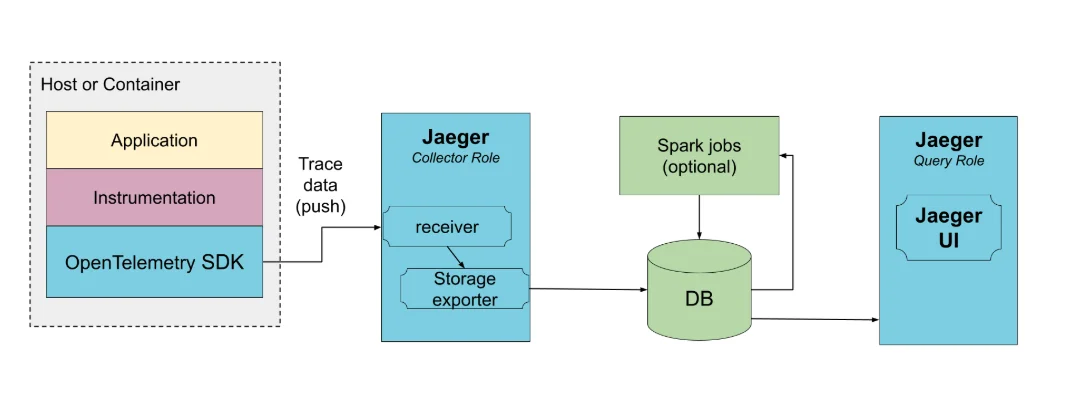
Data Collection and Traffic Handling
Jaeger uses collectors with an in-memory queue to manage short-term traffic spikes, but sustained spikes may cause data loss if storage can't keep up.
Sentry focuses on error tracking and performance monitoring, capturing events and organizing them into issues, without the same emphasis on traffic management as Jaeger.
Sampling and Data Capture
Jaeger employs a configurable sampling algorithm, with 0.1% of requests sampled by default, balancing data capture with system performance.
Sentry captures real-time errors and performance issues during user interactions but does not mention sampling explicitly.
Scalability and Flexibility
Jaeger's architecture is built to scale efficiently, especially for large volumes of trace data in microservices environments.
Sentry is designed for error tracking and performance monitoring, with less emphasis on handling massive trace volumes compared to Jaeger.
Customizations and integrations
- Customizability Jaeger offers a highly customizable and extensible platform, allowing developers to configure the system according to their specific needs. One of its key strengths is the ability to adjust the sampling rate, enabling developers to control the amount of data captured. On the other hand, Sentry provides a simpler configuration that focuses primarily on error tracking, with fewer customization options for distributed tracing. While Sentry supports custom error grouping and basic issue tracking, it lacks the deep configurability Jaeger offers for handling tracing data at scale, especially in complex environments like Kubernetes.
- Integration with OpenTelemetry Jaeger operates independently but can be integrated with the OpenTelemetry Collector, which can run as a sidecar, host agent/daemon, or central cluster. The OpenTelemetry Collector supports Jaeger's Remote Sampling protocol, which allows it to either serve static configurations directly from config files or proxy requests to the Jaeger backend for adaptive sampling. This integration simplifies SDK configuration by pointing both trace export and sampling endpoints to a local host, eliminating the need for remote service discovery. It also enables data enrichment, such as adding Kubernetes pod names, and distributes the resource load for enrichment across all application hosts, though it introduces overhead due to marshaling and unmarshaling data. In contrast, Sentry integrates with external tools for alerts and notifications but lacks the same level of flexibility and integration with OpenTelemetry. Sentry does not support the advanced data enrichment capabilities or intricate integration features that Jaeger offers, especially when dealing with distributed systems.
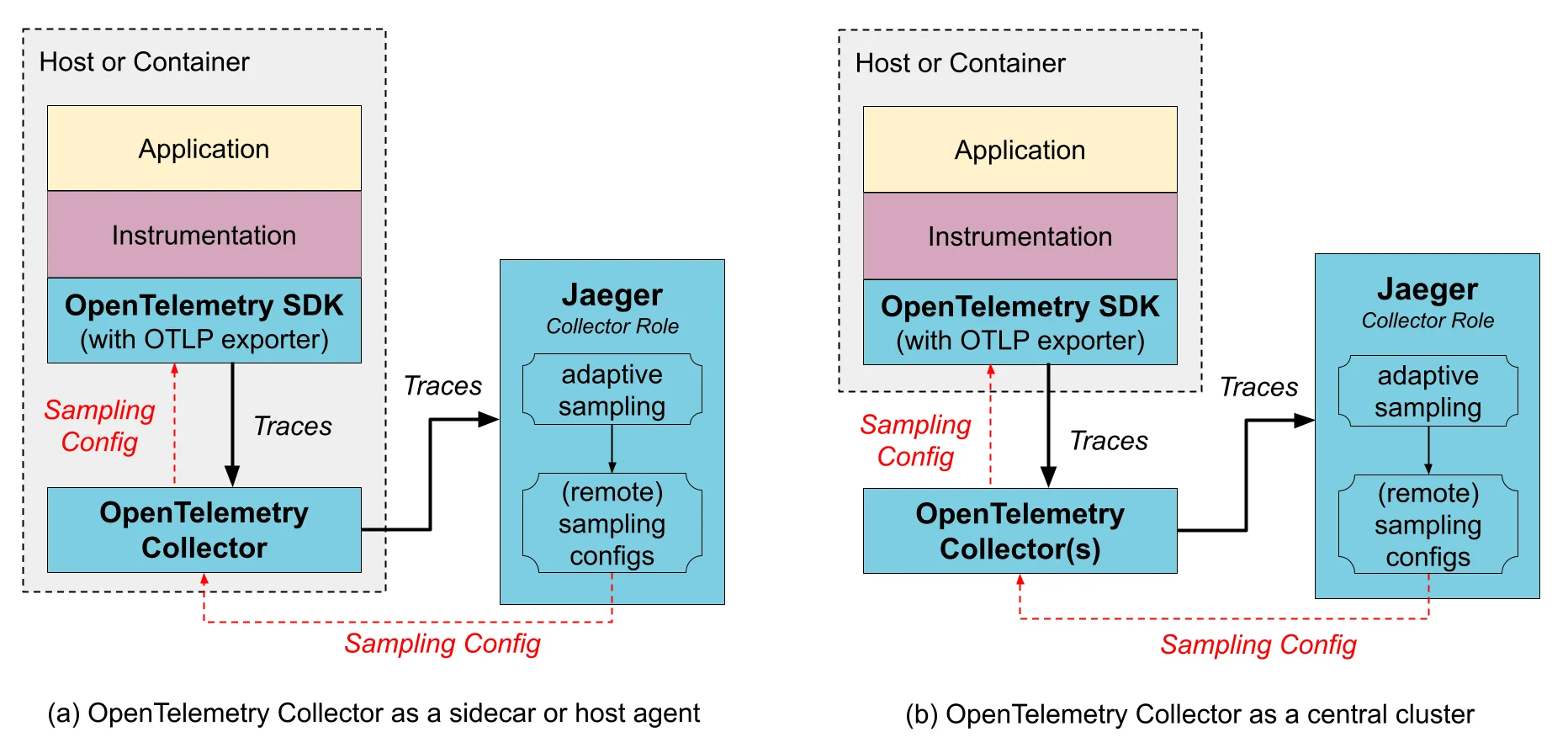
Jaeger's integration with OpenTelemetry Collector - Distributed Tracing Jaeger excels with its advanced configurability, particularly in large-scale and complex environments like Kubernetes. It offers features such as remote and adaptive sampling, which can fine-tune the tracing process to ensure that only relevant data is collected. This flexibility makes it suitable for teams that need detailed control over their tracing data. On the other hand, Sentry is focused mainly on error tracking and grouping based on error patterns. While it provides basic performance monitoring and release tracking, it does not offer the same in-depth distributed tracing features as Jaeger, limiting its capabilities for complex tracing scenarios.
Security and compliance
| Aspect | Jaeger | Sentry |
|---|---|---|
| Encryption | Relies on underlying storage encryption | End-to-end encryption for data |
| RBAC | Limited, depends on hosting environment | Basic RBAC capabilities |
| Compliance | Dependent on hosting setup | SOC 2, GDPR |
Jaeger is an excellent choice for teams focused on distributed tracing in microservices, while Sentry serves as a great complement for tracking errors, performance anomalies, and overall application health. Together, they can provide a comprehensive observability solution for modern applications.
Jaeger specializes in distributed tracing for microservices architectures, offering deep insights into service dependencies and performance bottlenecks.
10. DataDog
The Datadog Agent is an open-source software tool that runs on various hosts, gathering events and metrics to send to Datadog for monitoring and performance analysis. It supports a broad spectrum of environments, including local systems (Windows, macOS), containerized platforms (Docker, Kubernetes), on-premises data centers, virtual machines, cloud instances (AWS EC2, GCP GCE), bare metal servers, and even Raspberry Pi devices. It excels in monitoring everything from application performance to system health, offering a centralized platform for managing both infrastructure and application-level insights.
Key Features:
- Full-stack observability: Includes logs, metrics, and traces to offer a complete view of your application's performance and health.
- AI-powered alerting and anomaly detection: Automatically detects anomalies and triggers alerts based on AI-driven insights.
- Extensive integration ecosystem: Supports a wide range of integrations with cloud platforms, services, and tools.
- Custom dashboards and reporting: Allows users to create tailored dashboards for real-time monitoring and performance tracking.
| Pros | Cons |
|---|---|
| ✅ Comprehensive monitoring with multiple views for error tracking, performance analysis, and infrastructure monitoring | ❌ Can be overwhelming for teams only needing error tracking |
| ✅Excellent data correlation, linking APM, synthetic monitoring, and infrastructure metrics | ❌ Pricing can escalate quickly with increased usage |
| ✅ Datadog is an APM and observability sandbox, meaning it can be molded to fit specific needs. | ❌ High setup and operational overhead for simple use cases |
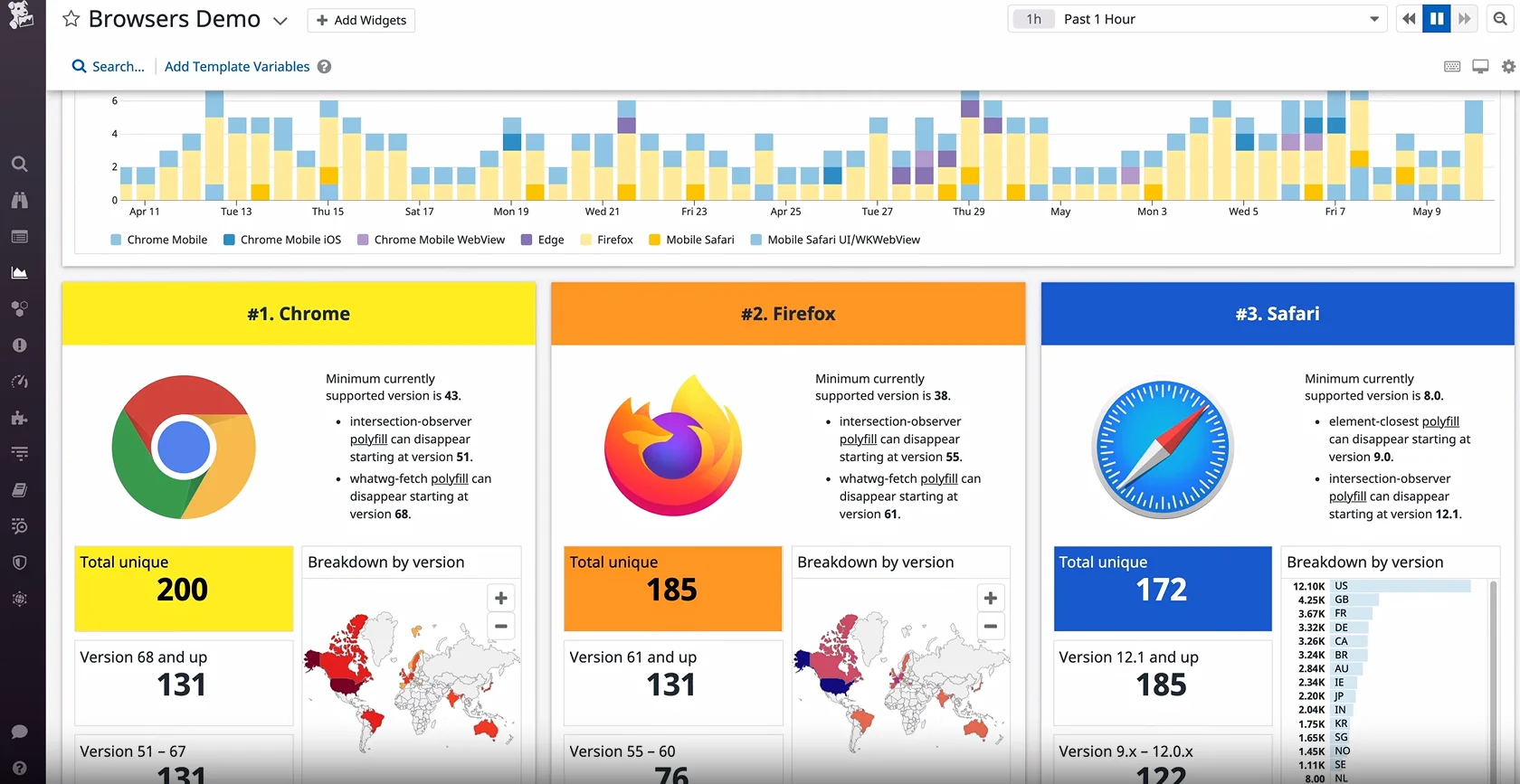
Comparison to Sentry
Datadog provides a more extensive monitoring solution compared to Sentry, potentially replacing multiple tools but with added complexity and cost. To put it briefly, if you find error tracking and real-time application performance data crucial for your monitoring stack, then Sentry is the right tool. If you are building an observability suite and want to start with something out-of-the-box, Datadog is just the right tool.
Pricing
- Pricing Model Datadog uses a per-host pricing model, which can get expensive quickly, especially with additional features like APM, infrastructure monitoring, RUM, and extended data retention. Sentry charges based on event volume and user seats, making it more affordable for smaller-scale use but requiring extra integrations for full observability.
- Cost Predictability Datadog's per-host model can result in scalable costs, making it harder to budget as infrastructure grows. Sentry offers more predictable pricing based on events and users but can become costly with increased event volume and additional features.
- Coverage and Integrations Datadog provides comprehensive features with broad coverage, including APM, infrastructure monitoring, and RUM, but at a higher cost. Sentry offers basic event monitoring, requiring additional integrations to match Datadog's level of observability, potentially increasing complexity and cost at scale.
Instrumentation and performance overhead
- Resource Overhead While the Datadog Agent can cause higher CPU and memory usage in resource-constrained environments, its extensive feature set justifies the trade-off. In contrast, Sentry's lightweight monitoring is more optimized for front-end and mobile applications, resulting in lower resource consumption.
- Monitoring Features Datadog offers advanced monitoring capabilities, including performance analysis and synthetic monitoring, which simulate user flows and requests to detect issues proactively. Sentry, however, focuses on real-user monitoring, capturing live errors and performance issues during actual user interactions but lacks Datadog's preemptive monitoring tools.
- Proactive Debugging Datadog's synthetic monitoring allows it to identify and address potential performance problems before they impact end users. Sentry, by comparison, excels in diagnosing issues after they occur but doesn't provide the same level of early-stage performance tuning.
Data Architecture
- Backend Architecture Datadog employs a managed backend with a proprietary ingestion pipeline optimized for scalability, making it ideal for high-throughput environments but leading to higher costs for data retention and querying. Sentry uses a ClickHouse-based storage engine for efficient event data storage and querying, with a self-hosted option that provides more control but requires significant resources for scaling, particularly in large environments.
- Suitability for Use Cases Datadog excels in high-throughput environments where infrastructure-level metrics and large-scale data ingestion are essential, thanks to its managed backend and scalability. Sentry is more focused on application-level error events, making it less suitable for infrastructure-level metrics or handling large-scale data environments like Datadog.
- Flexibility and Control Datadog offers a fully managed solution, providing ease of use and automatic scalability but less control over backend configurations. Sentry provides the option for self-hosting, offering greater control over storage and scaling strategies, though this adds management complexity
Customizations and integrations
- Incident Management: Datadog offers a comprehensive incident management suite with flexible alerting and manual/automatic incident declaration, but lacks advanced features like on-call scheduling and complex escalations. While sentry simplifies incident management by treating each new issue as an incident and allows custom issue handling, acknowledging, resolving, and defining code ownership and notification workflows. It lacks advanced features like on-call scheduling or phone-based alerting.
- Alert Configuration: Datadog provides a customizable alerting system with variables and rules, offering more complex configurations. **Sentry's features a more straightforward, click-based alert configuration with conditional statements, but lacks advanced alerting options.
- CI/CD Integration: Datadog provides extensive CI/CD integrations, such as deployment tracking, custom error grouping, and support for IaC tools like Terraform. Sentry, primarily focuses on error tracking and reporting within the development pipeline, offering advanced error grouping algorithms but fewer CI/CD hooks and APIs than Datadog.
Security and compliance
| Aspect | Datadog | Sentry |
|---|---|---|
| Encryption | Symmetric encryption - AES-GCM (256-bit key) and Asymmetric encryption - RSA (4096-bit key) | AES-256bit encryption at rest; HTTPS TLS connections for data transmission. |
| RBAC | Offers three default roles: Admin, Standard, and Read-Only. Users can create custom roles to control access. | Basic RBAC with roles like Billing, Member, Admin, Manager, and Organization Owner. |
| Compliance | SOC 2, GDPR, HIPAA, ISO 27001 | SOC2 Type I & II, HIPAA Attestation, ISO 27001. |
Datadog delivers comprehensive monitoring and observability features with extensive integrations, ideal for organizations requiring a complete DevOps monitoring solution.
Additional Considerations for Choosing a Sentry Alternative
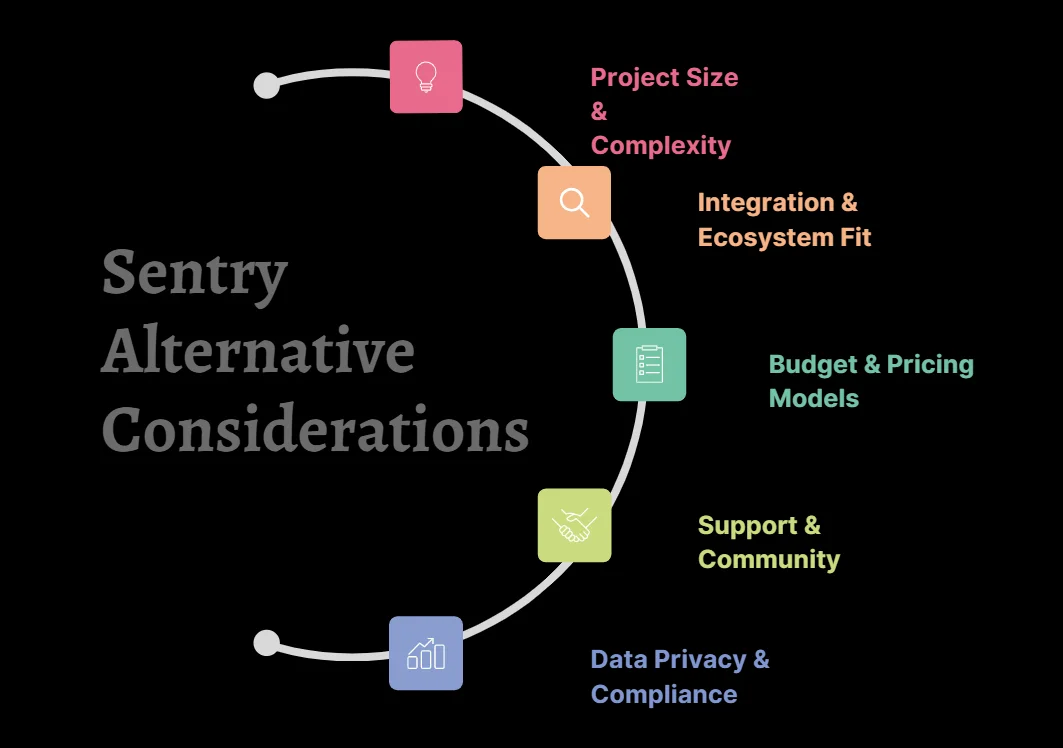
Selecting an alternative to Sentry involves a thorough evaluation of technical, operational, and compliance aspects to ensure the chosen tool aligns with your needs. Below are key factors to consider in detail:
- Project Size & Complexity
- Scalability: Verify the tool can scale with your application, whether it's a microservices architecture, a monolithic system, or a serverless setup. Look for features like distributed tracing and support for asynchronous workflows. Distributed tracing helps scalability by providing a comprehensive view of how requests flow through a system, making it easier to identify bottlenecks and optimize performance as the application grows. Similarly, support for asynchronous workflows ensures accurate monitoring of background tasks and parallel processes, which are crucial in handling increased load efficiently.
- Technology Stack: Confirm the tool supports your tech stack, including programming languages, frameworks, and runtime environments. For example, check if it has native integrations for Python, Java, Node.js, or other languages you use. Additionally, ensure the tool aligns with your deployment strategy, whether it's cloud-based, on-premises, or hybrid, and supports containerized environments like Docker or orchestration tools like Kubernetes.
- Event Throughput: Ensure the solution can handle your expected volume of error events and traces without performance degradation. Look for features like rate limiting, batching, or load balancing to ensure efficient processing at scale. Additionally, verify the tool's ability to handle peak traffic periods without slowing down or losing data.
- Budget & Pricing Models
- Usage Metrics: Assess pricing models based on key metrics such as the number of events, traces, or seats. For high-traffic applications, tools offering unlimited events with flat-rate pricing might be cost-effective. Consider whether the tool offers tiered pricing or pay-as-you-go plans that align with your usage patterns.
- Hidden Costs: Look for potential additional expenses, such as charges for data retention extensions, API usage, or integration with external tools like Slack or PagerDuty. Be mindful of potential "gotchas" like fees for advanced features, historical data access, or additional storage beyond the basic plan.
- Trial Period: Try to opt for tools that provide a free trial or tier, allowing you to evaluate their features without commitment. This can help you test scalability, usability, and integration capabilities before fully committing.
- Integration & Ecosystem Fit
- CI/CD Integration: Ensure the tool integrates seamlessly with your continuous integration and deployment pipelines. For example, check compatibility with GitHub Actions, Jenkins, or GitLab CI/CD for tracking deployment-specific issues. Also, verify whether the tool supports version control systems for automatic release tracking and issue linking.
- Observability Suite: Verify that the error tracker can complement your existing observability stack. Look for out-of-the-box support for metrics and logging correlation, and check if the tool integrates well with monitoring platforms like Prometheus, Grafana, or Datadog.
- Automation Support: Ensure the tool provides robust APIs or SDKs for automating workflows, such as custom alerts or automated ticket creation in systems like Jira or Trello. Additionally, check whether the tool supports webhooks to integrate with other alerting or notification systems.
- Data Privacy & Compliance
- Regulatory Adherence: Verify the solution complies with regulatory frameworks like GDPR, HIPAA, or CCPA. This is especially crucial if your application handles sensitive user data. Ensure the vendor provides details about their compliance certifications and regularly updated audit reports.
- Data Residency: Check if the tool allows you to specify data storage locations to meet local data residency requirements. Confirm if the solution supports multiple regions or cloud providers for better control over data sovereignty.
- Anonymization Features: Ensure it provides capabilities to redact or mask sensitive data from logs and error traces. Look for configurable settings that can automatically remove or obfuscate personally identifiable information (PII) or other sensitive data points.
- Support & Community
- Documentation Quality: Evaluate the depth and clarity of the documentation. Look for comprehensive guides, API references, and troubleshooting sections. Ideally, documentation should be frequently updated with examples and real-world use cases.
- Support Channels: Check the availability of support through live chat, email, or dedicated account managers for enterprise-level plans. Also, assess the availability of service-level agreements (SLAs) for support response times, especially for critical issues.
- Community Engagement: Look for an active user community or forums where you can get quick resolutions for common issues. Open-source tools often have strong GitHub communities for reporting bugs and sharing plugins. You should also assess the vendor's involvement in online communities or forums, as this can indicate the level of investment in customer satisfaction.
Comparing Scalability and Pricing Models
| Tool | Pricing Model | Scalability & Resource Usage | Ideal For |
|---|---|---|---|
| SigNoz | Usage-based / Self-hosted | Highly scalable, resource-efficient | Teams valuing data control and customization |
| Better Stack | Usage-based | Good for medium to large-scale apps | Log-centric monitoring approaches |
| LogRocket | Session-based tiers | Scales well for front-end heavy apps | Customer-facing application teams |
| Dynatrace | Consumption-based | Enterprise-grade scalability | Large, complex IT environments |
| AppSignal | Tier-based | Efficient for Ruby/Elixir apps | Ruby and Elixir development teams |
| Bugsnag | Event-based tiers | Good for diverse platform support | Mobile and web development teams |
| New Relic | Consumption-based | Highly scalable, resource-intensive | Organizations needing full-stack observability |
| Raygun | Event-based tiers | Scales well for most applications | Teams focusing on user experience |
| Jaeger | Self-hosted / Free | Highly scalable for tracing | Microservices architectures |
| Datadog | Host-based + Features | Enterprise-grade scalability | DevOps-centric organizations |
Migrating from Sentry
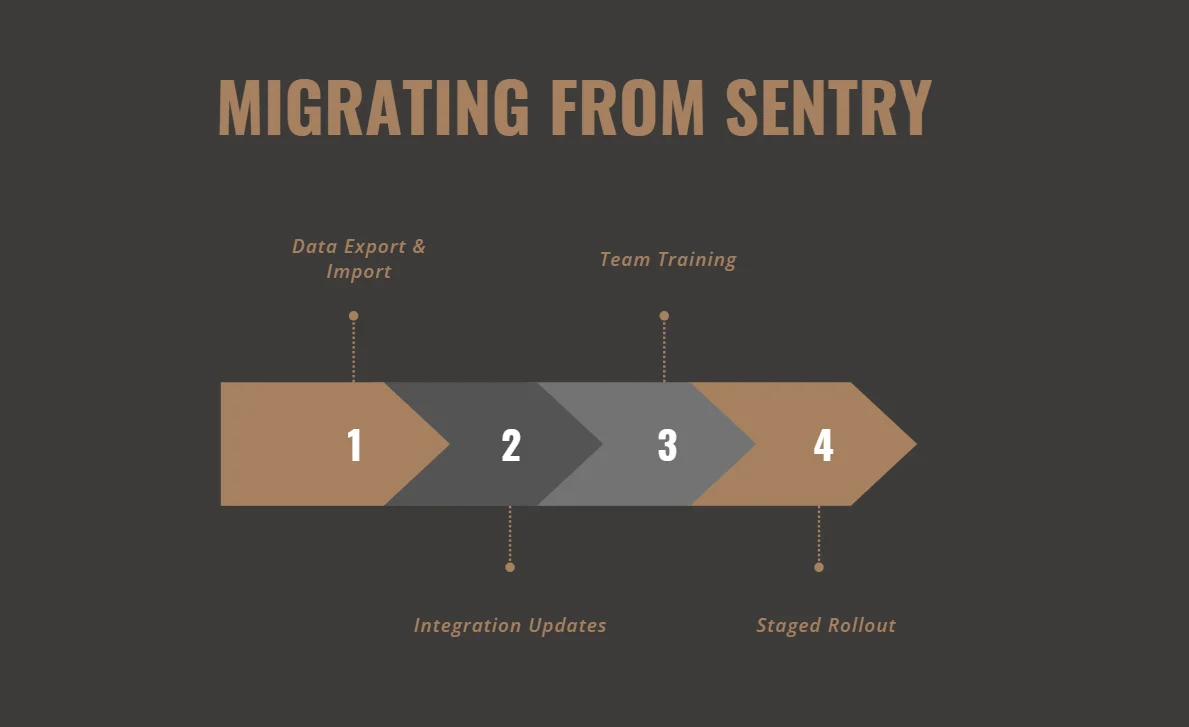
Transitioning from Sentry to a new error-tracking solution involves technical considerations that ensure continuity, accuracy, and efficiency in error-tracking processes. Here's a detailed guide:
Data Export & Import
Export Data from Sentry: You can export Discover query results as a
.csvfile by following these steps:- Go to the Discover page and choose the data source: Errors or Transactions.

- Refine the results using the search bar.
3. Select the desired columns using the Columns button.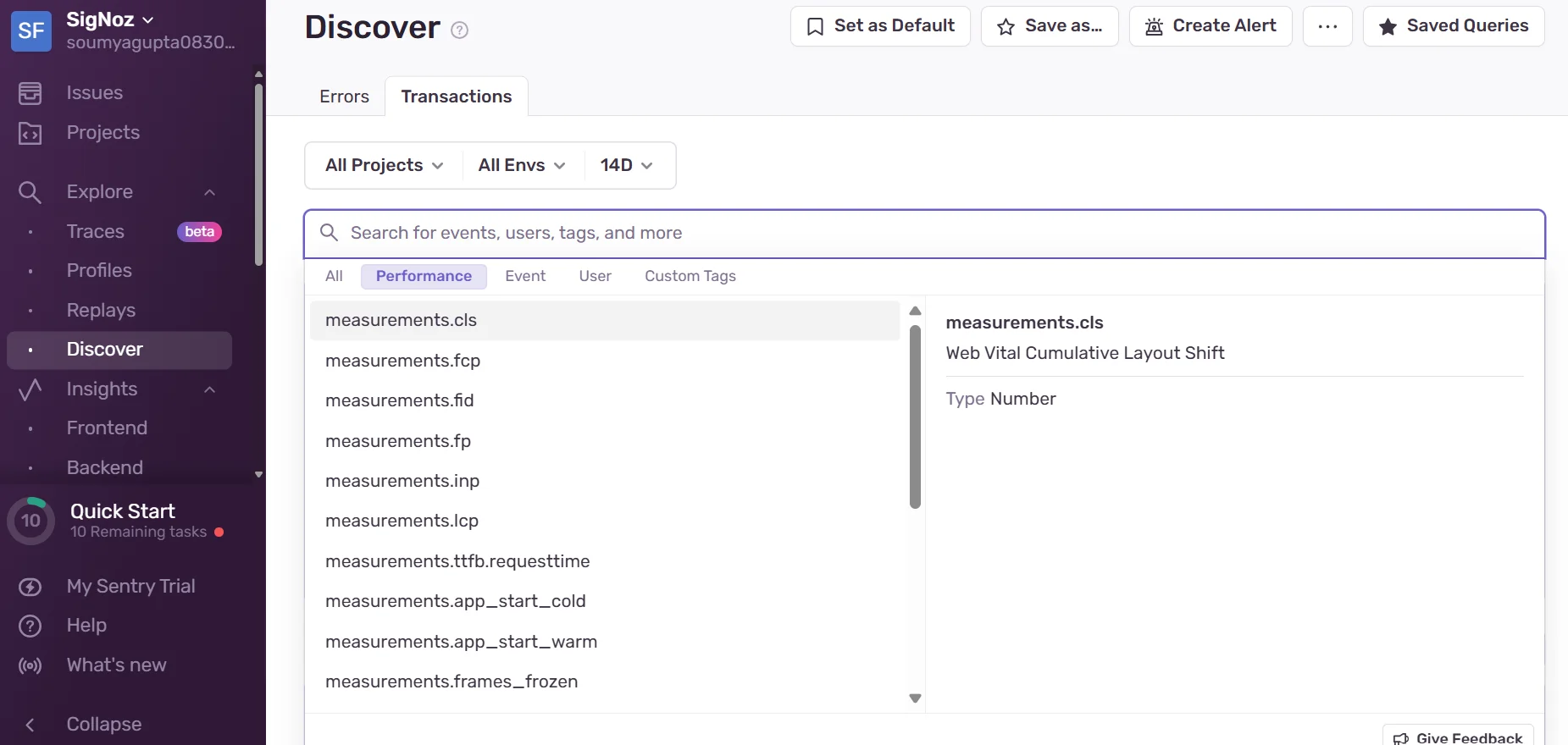
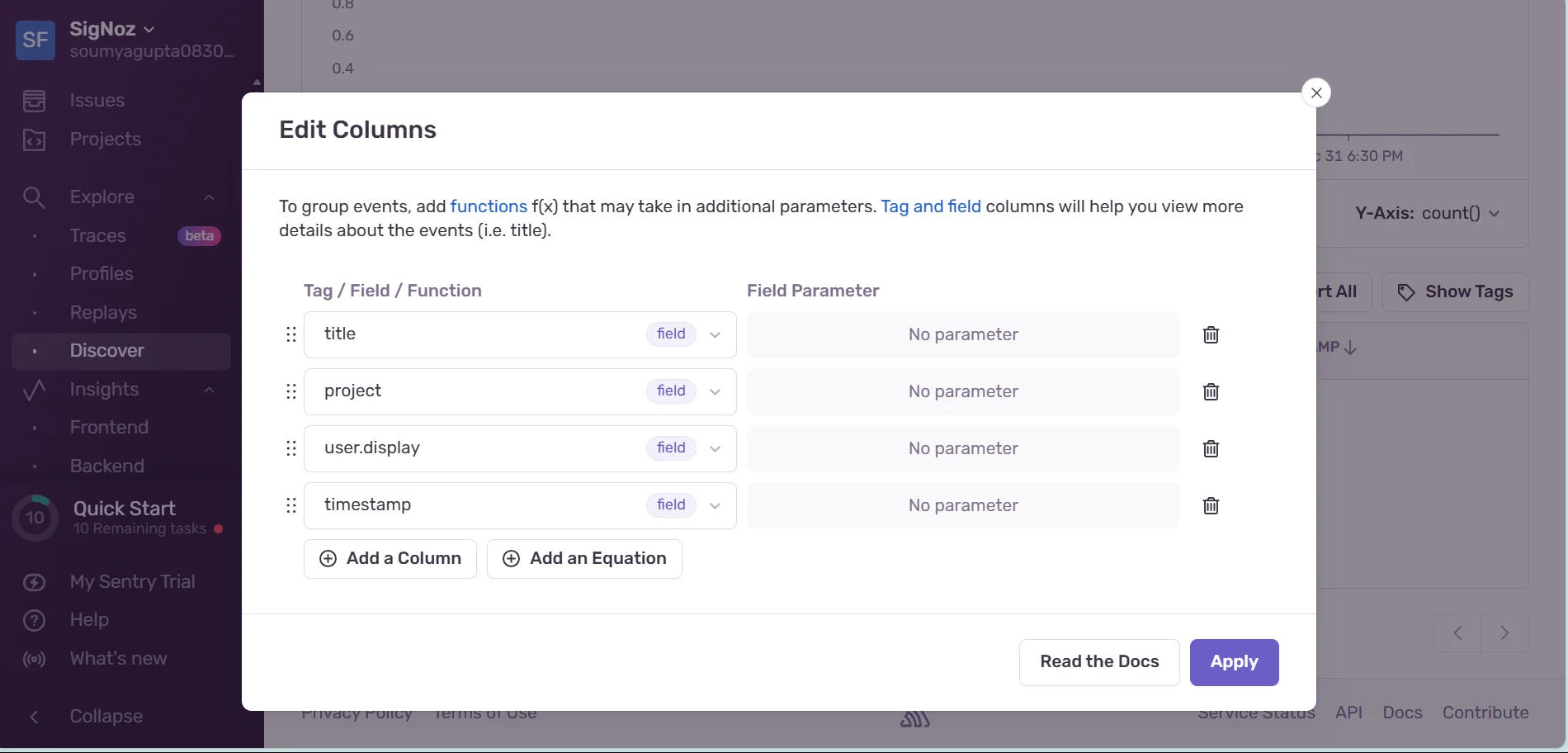
- Click on Export all.
Once the data is ready, Sentry will send a download link to your primary email address. Alternatively, you can use the Open in Discover button from the issues or performance pages and then click Export all.

Sentry Export All feature Note: This feature is available only for organizations on the Business or Enterprise plan.
Import to the New Tool: Verify if your chosen error tracking solution supports direct import of Sentry data. For example, some tools provide scripts or APIs to map and ingest Sentry's JSON export format. If no direct importer exists, write a custom script to transform the exported data into the required format using Python, Node.js, or your preferred language.
Integration Updates
Remove Sentry SDK: Locate and remove all references to the Sentry SDK from your codebase. This includes initialization calls (e.g.,
Sentry.init()), breadcrumb captures, and context updates. Use your build tools (likegrep,ripgrep, or IDE search) to find and clean up Sentry-related code.Integrate New SDK: Install the new error tracking tool's SDK (e.g., OpenTelemetry for distributed tracing and error monitoring). Follow the documentation to configure it, including initialization, contextual data injection, and setting up custom spans for better observability. For example, in Python, you might use
pip install opentelemetry-distroand configure it in your application startup files.Update Custom Logic: Migrate any custom logic like user session tracking, filtering sensitive information, or sending alerts to the new tool's APIs. For instance, suppose your application tracks user sessions in Sentry using
Sentry.setContext()you can migrate this functionality to a new tool like sayNewTrackersentry_sdk.init(dsn="your-sentry-dsn") sentry_sdk.set_context("user", { "id": "12345", "email": "user@example.com", "role": "admin" }) sentry_sdk.capture_message("User performed an admin action")Now, in your
NewTrackeryou can update this custom logic asnew_tracker.init(api_key="your-newtracker-api-key") new_tracker.set_metadata({ "user": { "id": "12345", "email": "user@example.com", "role": "admin" } }) new_tracker.log_event("User performed an admin action", level="info")
Team Training
- Hands-On Tutorials: Provide step-by-step training to familiarize your team with the new tool's dashboard, alerting mechanisms, and error tracking features. Use sandbox environments for live demonstrations.
- Internal Documentation: Write internal guides specific to your workflows. Include details like how to triage errors, customize dashboards, and integrate alerts with tools like Slack, or Microsoft Teams.
Staged Rollout
Parallel Monitoring: Initially run Sentry alongside the new error tracker to benchmark their outputs. Use this phase to identify gaps in data collection or discrepancies in error reporting. Tools like
tcpdumporWiresharkcan help analyze network traffic for API discrepancies. Following the example, we've used ofNewTrackerabove let's see an example where we send error data to both Sentry andNewTrackerfor comparison:sentry_sdk.init(dsn="your-sentry-dsn") new_tracker.init(api_key="your-newtracker-api-key") def track_error(error_message, error_context): sentry_sdk.set_context("error_context", error_context) sentry_sdk.capture_message(error_message) new_tracker.set_metadata({"error_context": error_context}) new_tracker.log_event(error_message, level="error") try: 1 / 0 except ZeroDivisionError as e: error_context = {"type": "ZeroDivisionError", "details": str(e)} track_error("An error occurred: Division by zero", error_context)Gradual Transition: Migrate a subset of your application services to the new tool first, starting with non-critical ones. Validate that the tool captures and processes logs, traces, and metrics accurately before scaling up.
Automated Validation: Set up automated tests to verify that the new tool captures expected exceptions, logs, and contextual information. For example, use unit tests to simulate errors and ensure the expected error metadata is recorded in the new system.
Migrating from Sentry to SigNoz

If you've chosen SigNoz as your Sentry alternative, follow these steps:
Set Up SigNoz
Begin by choosing the appropriate deployment model for SigNoz. If you opt for the cloud offering, simply create an account and follow the onboarding process.
For the self-hosted option, ensure you have the required infrastructure and install SigNoz using its Docker Compose or Helm chart setup. Verify that the platform is running correctly by checking its user interface and initial metrics.
Integrate OpenTelemetry SDK
OpenTelemetry serves as the backbone for SigNoz. Select the OpenTelemetry SDK for your application's programming language and integrate it following SigNoz's language-specific documentation.
This involves configuring the SDK to send trace and error data to SigNoz. Include instrumentation for critical application components such as HTTP requests, database queries, and custom spans to ensure comprehensive monitoring.
Here are some popular language-specific OpenTelemetry instrumentation guides to help you get started:
- OpenTelemetry Python Instrumentation
- OpenTelemetry Javascript Instrumentation
- OpenTelemetry Java Instrumentation
- OpenTelemetry Go Instrumentation
- OpenTelemetry PHP Instrumentation
and many more.
Match Error Capturing
When migrating from Sentry to SigNoz, it's important to match errors correctly. SigNoz ties errors to traces and spans, so you need to ensure that error events from Sentry align with the new tracing context in SigNoz for accurate tracking.
When comparing error capturing between Sentry and SigNoz, the key difference lies in their integration and focus areas. Sentry captures errors using its SDK through the
capture_exceptionmethod, which either accepts a caught exception directly or relies on the current exception fromsys.exc_info(). This method sends exceptions as events to Sentry's backend for analysis and storage, offering rich debugging information like stack traces and breadcrumbs.On the other hand, SigNoz, built on OpenTelemetry, captures errors within the context of traces. It uses the
record_exceptionmethod to convert exceptions into span events, associating errors directly with a specific trace.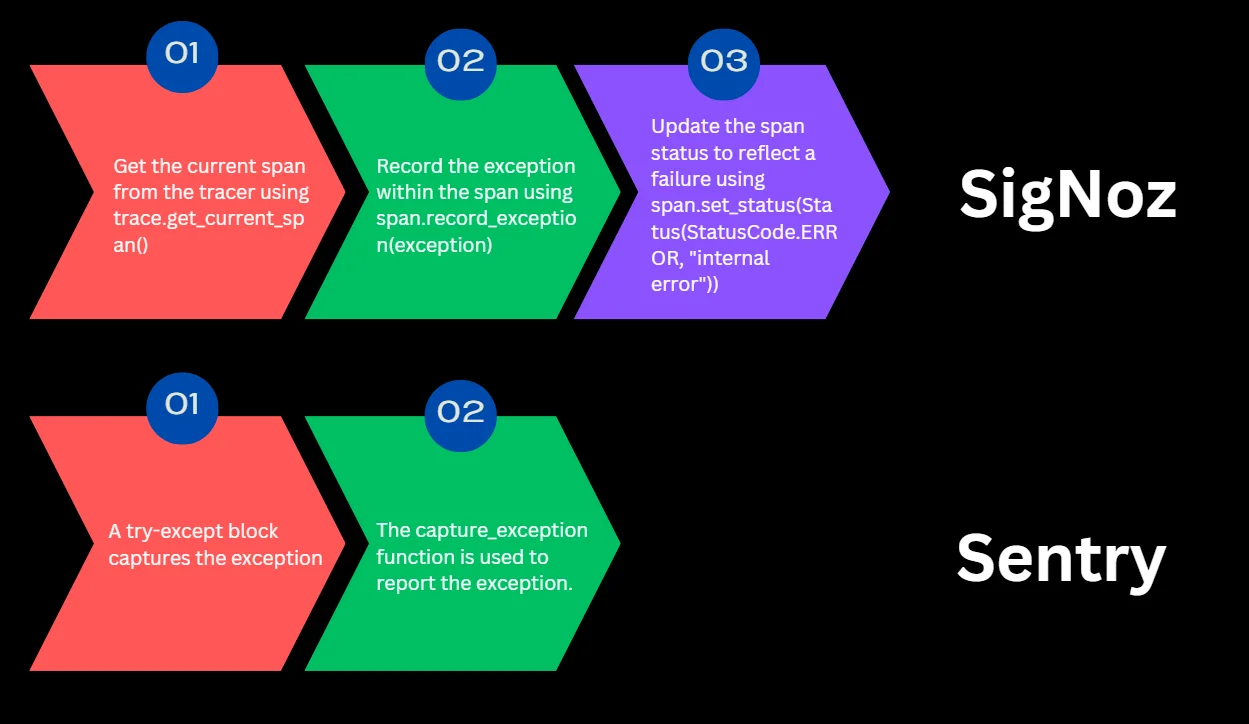
SigNoz vs Sentry exception handling Additionally, SigNoz updates the span status to reflect the failure, providing a more comprehensive context for observability that includes not only error reporting but also tracing and metrics.
While Sentry is primarily geared towards error monitoring and debugging with minimal setup, SigNoz provides a unified observability framework that combines error capturing, tracing, and metrics for deeper insights into application performance and failure.
Create Custom Dashboards
Recreate your most-used Sentry views in SigNoz. Use its dashboarding tools to design custom panels that provide insights into error frequency, response times, and affected users. Tailor these dashboards to align with your team's workflows, ensuring minimal disruption during the transition.
Set Up Alerts
Replicate critical notifications from Sentry in SigNoz by setting up alerts. Define thresholds for error rates, latency, and other key metrics, and configure alerting channels such as email, Slack, or PagerDuty. Test the alerts to ensure they trigger correctly and provide actionable information.
Staged Migration
Gradually shift your team's focus to SigNoz for error analysis. Start by monitoring both platforms in parallel, allowing your team to familiarize themselves with SigNoz while keeping Sentry as a fallback.
Compare the data captured by both tools to identify gaps or discrepancies. Once confident, fully transition to SigNoz and decommission Sentry.
Train Your Team
Provide your team with tutorials and training sessions on using SigNoz. Focus on navigating the interface, interpreting metrics, and leveraging OpenTelemetry for custom tracing.
Create internal documentation to ensure new team members can quickly adapt to the new system.
Monitor and Optimize
Post-migration, regularly review your SigNoz setup to optimize its performance. Analyze metrics and feedback to fine-tune dashboards, alerts, and instrumentation.
Stay updated on SigNoz's latest features to continuously enhance your monitoring capabilities.
Key Takeaways
- Sentry alternatives offer diverse features for error tracking and monitoring
- Consider factors like project needs, budget, and data privacy when choosing
- Open-source options like SigNoz provide customizable and privacy-focused solutions
- Evaluate integration capabilities with your existing development stack
- Consider full-stack observability platforms for comprehensive monitoring needs
FAQs
What prompted the search for Sentry alternatives in 2025?
Recent updates to Sentry's Terms of Service, along with pricing changes and an increasing demand for more customizable and privacy-conscious solutions, have prompted many teams to seek alternatives. Furthermore, the shifting landscape of application monitoring has brought new competitors offering innovative features.
How do open-source alternatives compare to commercial error tracking tools?
Open-source alternatives like SigNoz offer greater customization and data control but may require more setup and maintenance. Commercial tools often provide more polished interfaces and managed services but at a higher cost. The choice depends on your team's technical expertise, resource availability, and specific requirements.
Can I migrate my existing error data from Sentry to a new platform?
Most error tracking platforms don't offer direct imports from Sentry. However, you can often recreate your most important dashboards and alerts in the new system. Some tools may provide custom solutions for large-scale migrations. It's best to focus on forward-looking data collection while keeping historical Sentry data accessible if needed.
Are there any free Sentry alternatives suitable for small projects?
Yes, several Sentry alternatives offer free tiers or open-source options suitable for small projects:
- SigNoz provides a free, self-hosted option.
- Better Stack and Bugsnag offer free plans with limited event volumes.
- Jaeger is completely open-source and free to use, though it focuses more on tracing than pure error tracking.
When choosing a free option, consider future scalability and potential migration costs as your project grows.
